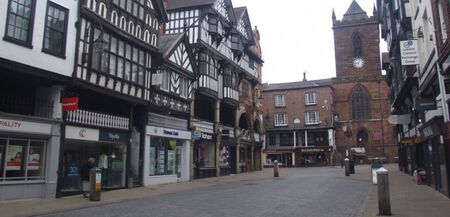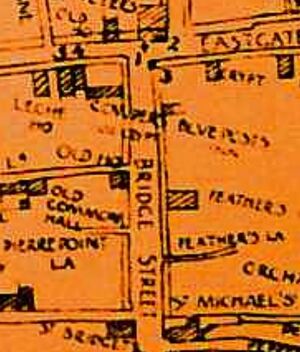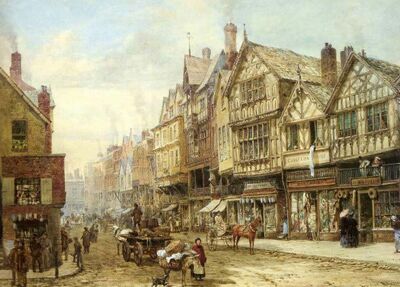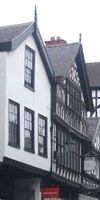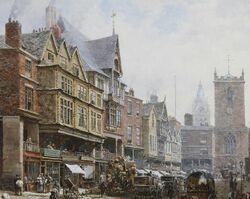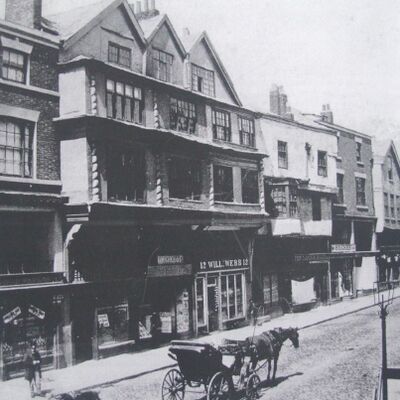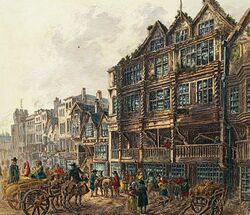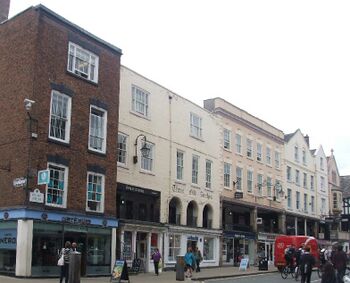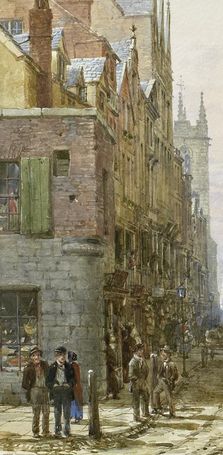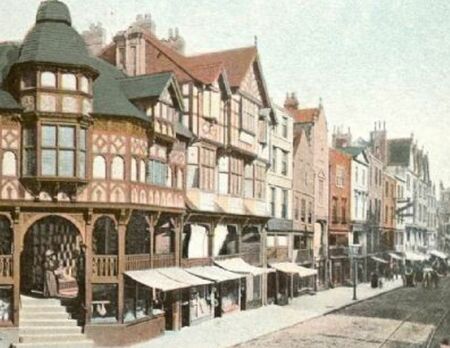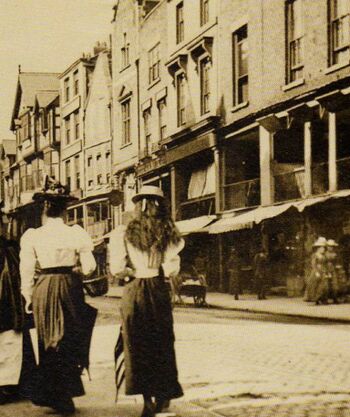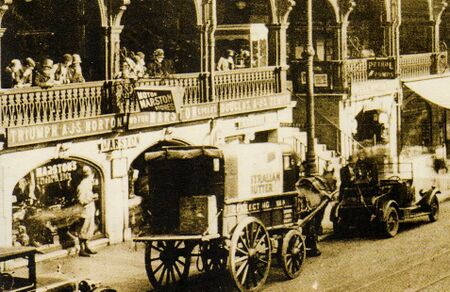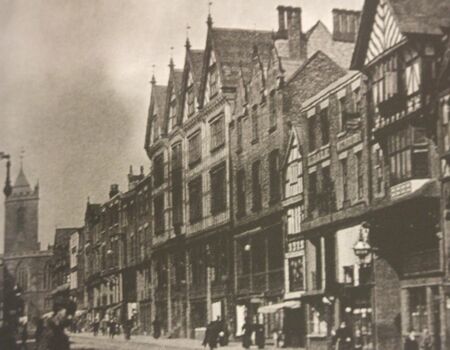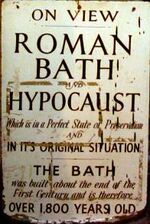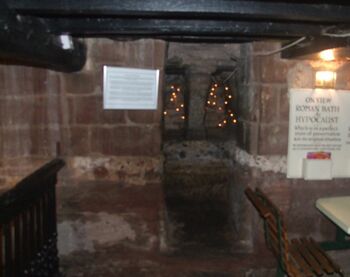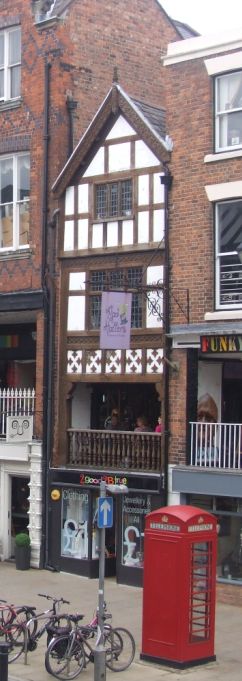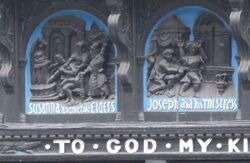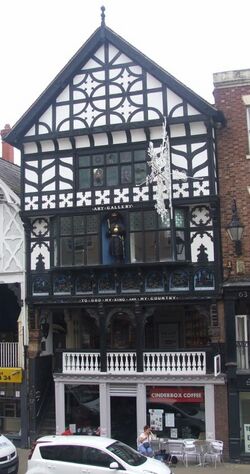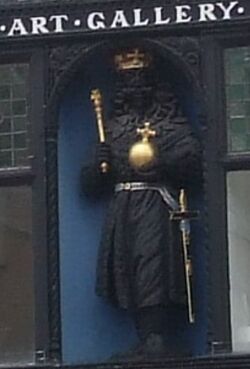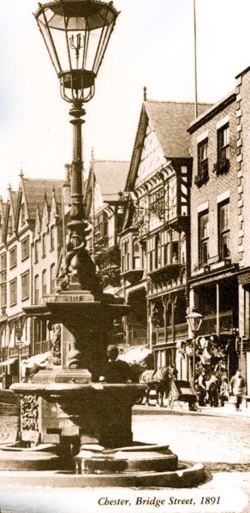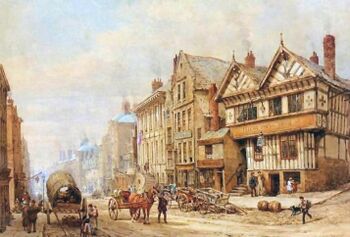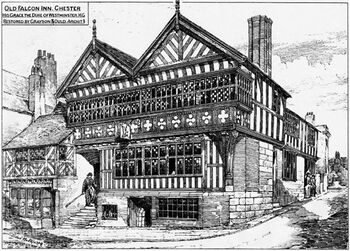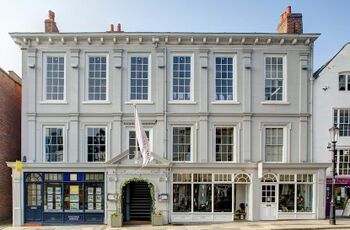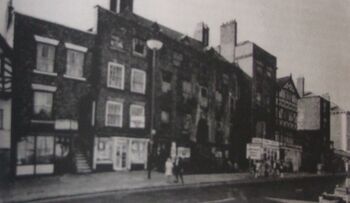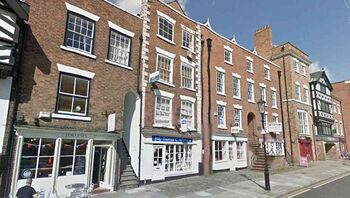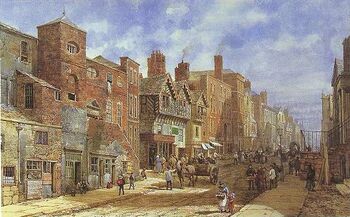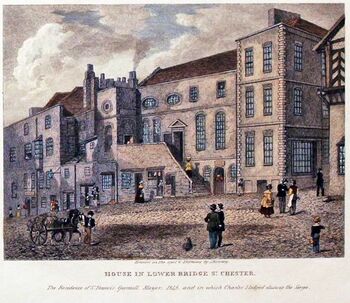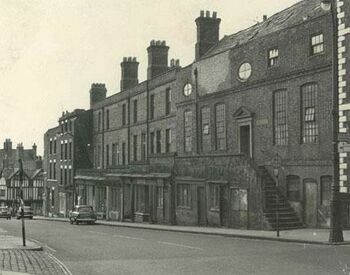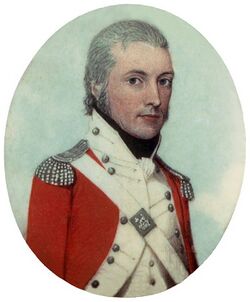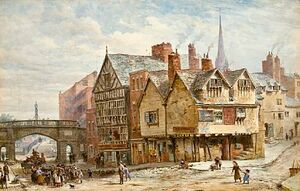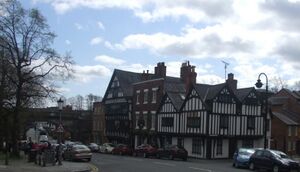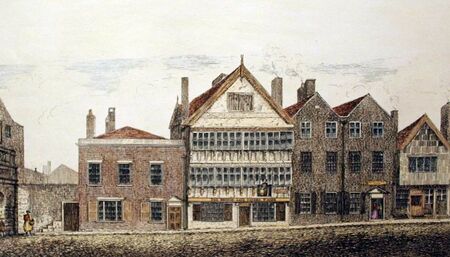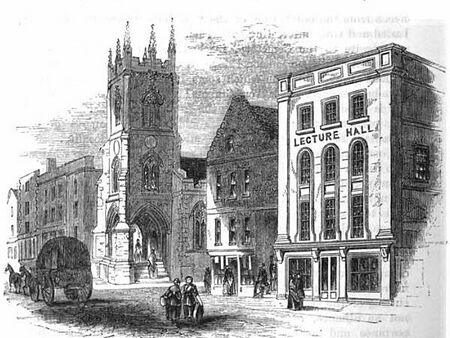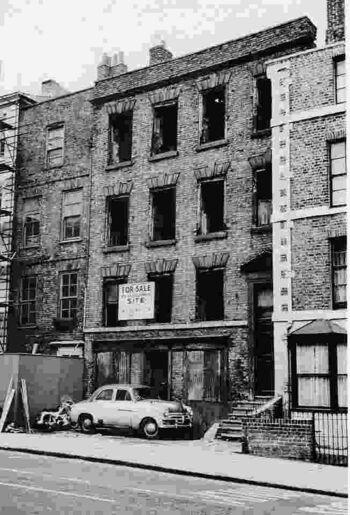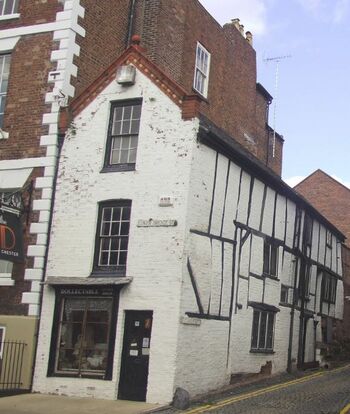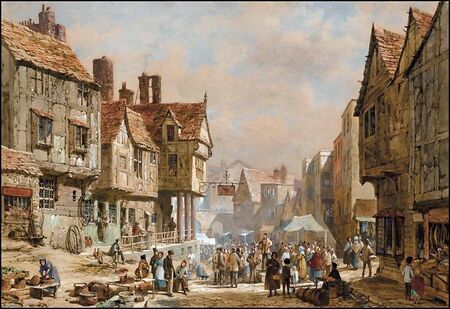Bridge Street

Bridge Street, along with Northgate Street, Watergate Street and Eastgate Street, is one of the four original streets built inside Roman Chester. All four streets meet at the High Cross. Bridge Street is one of the most painted and photographed locations in Chester and a remarkable record exists of its appearance over the years.
In Roman Chester the Via Praetoria marked the southern approach to the Roman Headquarters Building, whose front entrance faced straight down what is now Bridge Street. The the upper part of Bridge Street would have been the location of officers quarters, while further down were the legionary baths and the legionary hospital. The Roman City formally ended at the bottom of upper Bridge Street with the South Gate ("Porta Praetoria"), although there were further buildings outside of the walls of a non-military nature including the "Mansio", a roadside inn or posting house.
In the Dark Ages when the City Walls were enlarged, Lower Bridge Street was contained within them. Either at that time, or soon after, the Lower Bridge Street area seems to have become a centre for Scandinavian (Viking) settlement, with at least two churches in the area having Scandinavian connections - one being St Olave the other St Bridget. In Medieval times the upper part of the street played host to the various markets held in Chester: these only later moved to the area around the current Market Square in Northgate Street. Bridge Street was paved in around 1586. Prior to the dissolution of the various religious houses much of the land in Bridge Street was under their ownership. During the English Civil War, when Chester was besieged by Parliamentary forces in 1645, King Charles I entered the City via the Old Dee Bridge with 600 horse and stayed the night at Sir Francis Gamul's house on Lower Bridge Street (Gamul House today). From around the time of the Civil War, enclosure of The Rows, particularly in Lower Bridge Street, removed many of the existing Row structures.
The Rows once continued into Lower Bridge Street but only traces remain today (most clearly at no. 11 and at Gamul House, where a stepped platform at the frontage provides an interesting clue as to the possible origin of the Rows). By Georgian and Victorian times the better off were tending to desert the city centre, shop-owners increasingly abandoned accommodation over their premises to live in more salubrious suburbs, however, Bridge Street continued to be affluent. The Bridgegate itself dates from 1781-2 (by Joseph Turner), replacing an earlier structure and the spectacular waterworks tower. Lower Bridge Street was at this time lined almost continuously with tall 17th and 18th century buildings, being a popular location for the gentry to build houses. Today many Georgian townhouses survive and this era provides the dominant character of Lower Bridge Street. In the 1968 Conservation in Chester report the Bridgegate area was highlighted as "one of the worst examples of area decline", but following significant conservation and sensitive re-construction work in the last forty years the situation today is much improved and the area contributes a strong historic character to the City.
- Bridge Street on Chester Tourist (good for shopping information);
- Vanished Pubs in Bridge Street (Mr Howe is available to explain the history of Chester pubs for a few pints per pub).
Listed (and other) Buildings
Batenham says of Bridge Street that it:
- "Is to the south of the Cross and is about 550 yards long and tolerably wide. The antiquity of the city is in no place more conspicuous than in this interesting street every gradation of architecture from the rude clumsy wooden hat to the open airy commodious hotel is here displayed and it is not perhaps the least worthy of observation to see the awkward confinement of low close rooms gradually yielding to the more healthful taste of modern building. The original plan of the houses, (if plan there was) seems to have been in the cottage style with the gable end of each to face the street. This mode certainly gives great extent of premises behind but renders the inner rooms and staircases rather dark. The curious observer will discover in this street that the square brick fronts of some of the houses are nothing more than a wall carried up as high as the ridge of the roof, thus having the appearance of a handsome modern house while the interior retains most of its original formation".
Upper Bridge Street West (Cross to Commonhall Street)

The "Selds" are often mentioned in early records. That "Selds" were some form of marketplace is beyond doubt, but its far from clear whether these selds were constructed in the street in front of the buildings fronting The Rows, or top of the rows (and still along them), back from the rows (like long narrow shops) or even behind The Rows like shopping malls or small market halls. By the late 14thC the land at the corner of Bridge Street and Watergate Street was referred to as the stone or "staven" selds. Much earlier deeds from the 1270's refer to the "selda lapidea" (stone selds), so it appears that they were in place by as early as the 13thC. A "corvisor" was (originally) a leather worker using high quality Cordovan leather from Spain for such things as harness, gloves and riding boots. In 1356 the Mayor and corporation granted to William deBurgh (of Chester) a small piece of land which was identified as being next to the "new steps" which led towards "le Coryserrowe" (Corvisor's Row) and were located "at the end of the fishboards next to the the pillory of Chester, in that corner towards the Church of St Peter". Here then, the word "Row" is being associated with an elevated walkway running south from the Cross along the west side of Bridge street. While the steps were "new" in 1356, the Row appears older - before 1279 Robert Le Barn granted some properties "between the land of the Hospital of St John and that of Ralph of the Pillory" to Vale Royal Abbey. These are known from later records to contain premises used by a corvisor. A seld used at that time by the Corvisors/Shoemakers occupied the same site and appears to have had undercrofts ("celaria") beneath it by 1314.
For convenience, the addresses used her are the street addresses (the row addresses can differ up or down).
Numbers 2-8
Number #1, Watergate Street/2-8 Bridge Street: a Vernacular Revival corner building by Lockwood, possibly his best in Chester, erected for the 1st Duke of Westminster in 1892. The Ruabon brick, yellow sandstone and half-timbered facade shows Lockwood's inventive use of Baroque and Renaissance ornamentation. While this was the site of the mediaval "Staven Selds" of that nothing remains. Indeed, early photographs show a brick building already on the corner site before 1892, although the The Rows running through had been preserved. As was his usual practice Lockwood neither reused nor retained any of the earlier structure. On the corner the Row arcade has one round and one elliptical arch to Bridge Street and 2 elliptical arches to Watergate Street. The upper two storeys of the fourth bay in Bridge Street have a close studding of oak, jetties to each storey and herringbone struts to gables each with a richly carved frieze, console brackets and grotesque heads. The upper-storey windows in brick walls have moulded stone surrounds, mullions and transoms, while there are oriel windows on the oak-framed walls, some with round-arched middle lights. A wrought-iron sign bracket is provided on each street, that to Watergate Street having a bronze eagle's head. The brick-built and the half-timbered overlap as the Row seems to fit seamlessly into the arches at the corner. There is an oak-framed hip-roofed porch at Row level before No.3 Watergate Street, which shelters an S-shaped stair leading from the street to The Rows. Hughes (and many others) tell the following story:
- "A little way down this Row was an ancient tavern called the Blue Posts supposed to be the identical house now occupied by Mr Brittain woollen draper. In this house a curious incident is stated to have occurred in 1558 which tradition has handed down to us in the following terms. It appears that Dr Henry Cole, Dean of St Paul's, was charged by Queen Mary with a commission to the council of Ireland which had for its object the persecution of the Irish protestants. The doctor stopped one night here on his way to Dublin and put up at the Blue Posts then kept by a Mrs Mottershead. In this house he was visited by the mayor to whom in the course of conversation he related his errand in confirmation of which he took from his cloak bag a leather box exclaiming in a tone of exultation: "Here is what will lash the heretics of Ireland!". This announcement was caught by the landlady who had a brother in Dublin and while the commissioner was escorting his worship down stairs, the good woman prompted by an affectionate regard for the safety of her brother opened the box took out the commission and placed in lieu thereof a pack of cards with the knave of clubs uppermost. This the doctor carefully packed up without suspecting the transformation nor was the deception discovered till his arrival in the presence of the lord deputy and privy council at the castle of Dublin. The surprise of the whole assembly on opening the supposed commission may be more easily imagined than described. The doctor in short was immediately sent back for a more satisfactory authority but before he could return to Ireland Queen Mary had breathed her last. It should be added that the ingenuity and affectionate zeal of the landlady were rewarded by Elizabeth with a pension of £40 a year."
Another writer in "The Old Inns of Old England" states that:
- "The former "Blue Posts" .. was long since refronted in respectable, but dull, red brick, and is now, or was recently, a boot-shop. But although no hint of its former self is given to the passer-by, those who venture to make a request, are shown a fine upstairs room, with an elaborately pargeted ceiling, still known as the "Card Room".
The Cheshire Sheaf (July 1863) implies that the "Blue Posts" stood on the site of Number 8 and as noted above, old photographic evidence shows that there was a brick building on the site before Lockwood removed every trace. It is also possible that the Blue Posts was on the opposite side of Bridge Street.
There does seem to have been some special relevance assigned to the Jack of Clubs, in the reign of Queen Elizabeth I there were reports of the Jack of Clubs being left hanging in desecrated churches
Number 10
Number #10 Bridge Street; a somewhat intact 17thC timber-framed building with an undercroft, but restored over the years. The deep stall-board, 3m from back to front, is mostly 17thC with a minor 19thC encroachment. The fascia above the Row opening (the balustrade to the raised stallboard occupies almost the full height of the opening) is moulded and above is a band of five distinctive quatrefoil panels, which have probably been "refixed" during restoration (compare the modern building with that shown in the drawings by Louise Rayner and the old photograph above - in both cases the front of the building has a sign saying "COMPTON HOUSE" where the distinctive quatrefoil panels should be). The third storey has a slight jetty at sill level; the rendered wall above is painted as if timber-framed with herringbone braces. The jettied rendered gable, is painted as if timber-framed with herringbone struts. The shaped, fretted bargeboards and finial are probably 19thC imitations of 17thC elements. Inside the former arrangement of the building appears to have been a chamber above the Row walk and former Row level shop, a galleried hall open to the roof and a small rear chamber. Internal visible features of the 17thC structure include the north wallplate on posts and an inserted corbel.
Number 12
Number #12 Bridge Street: one of the most impressive buildings on the rows, formerly known as: Nos.2 AND 4 Cowper House BRIDGE STREET ROW (also formerly familiar to many as "Bookland"). The property was improved by Thomas Cowper a Royalist, and Mayor of Chester 1641-2, possibly after severe damage in the Civil War. A sandstone fireplace above the diagonal beams in the Row walk is inscribed TC (Thomas Cowper) 1661 to each side of a blank shield, and has a substantial projecting, moulded mantel. The property extends over 4 storeys including a medieval vaulted undercroft and Row level. A flight of 11 repaired stone steps north of the modern shopfront lead to the Row walk. On the ground floor the front undercroft, its present floor two steps below street level, is lined, however, six steps lead down through a mid 19thC Gothic Revival stone screen with archway on colonnettes and flanking windows in 13thC style, within a broad recessed arched panel, to a spectacular 6-bay quadripartite rib-vaulted rear undercroft. The undercroft was re-discovered in 1839 and is now thought to date from 1350-75, possibly even a little earlier. The undercroft has squared sandstone rubble walling, truncated-cone-shaped rib-corbels, deeply chamfered ribs and a 3-light window at the west end, formerly with trefoil heads but now heightened and with round heads. The undercroft is unique in that the ground at the rear is such that it can have a window so placed.
A trefoil archway in the fifth bay leads to a stone stair within the stone party wall with No.14, rising backward, and displaying the underside of an upper stair apparently serving Number 14 (which is actually not the case!). The rear undercroft was found and excavated in 1839, when the floor level may have been lower approx 0.6m. The front undercroft is 16m long, the rear undercroft 13m. The stall-board is again quite deep, approx 3m from front to back. There is carved fascia above Row opening, above that a seven-light mullioned and transomed leaded window c1870 stretching across most of the frontage. The strap-work carved on the jetty bressumer to the fourth storey is again inscribed TC (for Thomas Cowper) 1664 - which presumably refers to the date of repairs after the siege. Hughes writes of the undercroft as follows:
- "Previous to 1839, no special archaeological interest attached to this locality; but in that year while excavating for a warehouse behind the shop of Messrs Powell and Edwards, cutlers, a discovery was made which at once set all the antiquaries of Chester "by the ears". The late Rev J Eaton Precentor of the Cathedral, an architectural authority in his day, made the following Report upon this Ancient Crypt as it is called for the use of the proprietors .. The ancient Crypt discovered by Messrs Powell and Edwards is of an oblong form running from east to west The following are its dimensions viz length forty two feet breadth fifteen feet three inches height from the surface of the floor to the intersection of the groinings of the roof fourteen feet This Crypt was partially lighted through the upper part of the west end in which there are three small windows divided by stone mullions and protected by iron bars The upper part of the groining on the centre window appears to have been cut away to admit of more light On examining the intersection of the groins marks were discovered from the lead on the stone work that a couple of lamps had been used for lighting The entrance to the east end is by a flight of steps cut out of the rock to the height of three feet On the south side is an Anglo Norman Gothic doorway which is attained by three or four semicircular steps and forms an outlet within its inner and outer wall by another flight of steps to the surface above the building In a niche on the south side of the window is a font in excellent preservation "
It is interesting to compare photographs of this building with Louise Rayner's drawings. In a drawing made before 1873, number 12 does not have any "half-timbering on the front, but in a drawing dated after 1873 (using Lockwood's 1873 build as a guide) it can be seen that Cowper House has quite changed in appearance, now looking much more like its modern self. It can also be seen from Rayner's earlier drawing that prior to the 1870 alterations the windows at Row + 1 level were far less extensive.
Ghost
An apparition of a Victorian apprentice boy has been reported in an upstairs room. Apparently he fell on stone stairs at the rear of the medieval crypt. The spirit of unhappy 12 yr old Victorian orphan girl who hanged herself supposedly haunts the old bakehouse.
- Cowper House on Wikipedia;
- Cowper House on Cheshirenow;
Number 14
Number 14 Bridge Street: this undercroft and town house, appears to be 17thC from Row level upwards, but has been much altered internally. The south wall has been breached to create an extension to the south behind number #16, and there is no visible evidence of the staircase arrangement in the north wall which can be seen at Number #12. Access to the undercroft is not normally practical, but it is stated to have approx 4 feet 6 inches headroom beneath present street level floor, with a stone flag floor and squared rubble sandstone walls. It is believed to project beneath the pavement, and to be approx 30 feet long under the building. Despite its plain appearance the facade of number 14 seems to be on of the least "messed about" buildings in this section of Bridge Street as it consistently has the same appearance in all of the depictions of it.
Cowpers house may have included both 12 and 14
Numbers 16-18
Numbers 16 and 18 Bridge street, are listed, but of little interest. The rainwater head is dated 1804. Randolph Caldecott (22 March 1846 – 12 February 1886) a British artist and illustrator, was born here. Caldecott was his father’s third child by his first wife, Mary Dinah Brookes. In 1848, the family moved to Challoner House, Crook Street, Chester, and in 1860 to 23 Richmond Place, Boughton. His main education came with five years at the King's School, Chester, a grammar school then in the Cathedral. At the age of 15, in 1861, he left school and first had a drawing published, a sketch of a disastrous fire at the Queens Railway Hotel in Chester, which appeared in the Illustrated London News, together with his account of the blaze. Shortly thereafter he left Chester and spent the rest of his relatively brief life living elsewhere.
The Caldecott Medal was named in his honour. He exercised his art chiefly in book illustrations. His abilities as an artist were promptly and generously recognised by the Royal Academy. Caldecott greatly influenced illustration of children's books during the nineteenth century.
Number 20
Number 20 Bridge street is a tall Vernacular Revival building by Lockwood (1873), probably on site of two former undercrofts and town houses. This is Lockwood's earliest work in The Rows. and as often in his work, retained few elements of the previous building, except perhaps the flight of 12 steep steps south of the shopfront which ascend to the Row (these are visible in a pre-1873 photograph of the previous building). The tile and Art-Deco shopfront dating from the 1930's (from the "Plane Tree Cafe") no longer exists. Above the Row front a deep bressumer carries a jetty-beam on brackets and supports a front which is half-timbered with a brick infil. The third and fourth storeys have three bays, with the projecting central bay capped by a gable and the side bays small-framed. The third storey has a central canted 5-light oriel with convex pargeted sub-panels flanked by a cross-window in each side-bay. The fourth storey is again jettied, with the central bay having a timber balcony on shaped brackets with balusters and ornate corner-posts supporting the gable. As before, there are 2 cross-windows and each side-bay has a mullioned 2-light casement. The third and fourth storey windows retain shaped leaded stained glazing in upper lights but the former rectangular leaded panes in lower lights are removed. The gable has a coved jetty, herringbone struts, arched bargeboards and a weather vane.
Previous to the Lockwood building a rather ramshackle pile sttod on this spot and was distinguished by a large oriel window, which is shown both by Rayner and by Batenham.
Numbers 22-26
Numbers 22-26 the "Dutch Houses". This structure, with a distinctive facade and twisted, "barley-sugar" columns appears to have be built in medieval times. However, little of what can be seen today dates from that period. By the 1970's different parts of the building were in different ownerships and in order to carry out the urgent structural repairs needed the City Council purchased all these individual parts. The restoration (1973-1975) required was heavy and extensive, and involved the insertion of much steelwork and effectively the removal and replacement of the entire facade. Early photographs show that the barley-sugar columns had already been partly removed from the Row + 2 level. All that remains of the original building front are the sandstone pillars.
The central building of this range retains some extravagant "Carolian" plaster ceilings, which can still be seen today, but only by appointment if you are not a customer.
- Dutch Houses on wikipedia;
Number 28
Number 28, formerly "Ye Old Vaults" dating from around 1789 - (see rainwater head) which closed in 2002. The concrete footbridge over Commonhall Street was built in the 1970's.
Ghost
A spectral old landlord laments the state of his pub.
Upper Bridge Street West: Commonhall Street to Pierpoint Lane

This section of the street illustrates very well the confusion that can be caused by the peculiar numbering of the premises at street and row level, especially when modifications are made which combine previously separate premises.
Number 30
Number 30: this undercroft and town house, later became a public house, before 1899 the public house was the Harp and Crown, thereafter the Grotto. A painting by Louise Rayner shows the buildings as they were prior to renewal and with the stall-board partly enclosed.
Un-executed plans and perspective exist for rebuilding by John Douglas (dated 1873) the present structure was re-built in 1900 on a more modest scale by Douglas and Minshull. The front to Bridge Street has a carved bressumer above the Row opening and supporting capitals which are slightly out of true, it is unique for its period in central Chester in being no taller than the building replaced. The stall-board, 2m from front to back, formerly had an enclosed northern bay, used as a barber's shop. An S-shaped flight of steps, replaced in concrete, descends to Commonhall Street and a 1970s concrete footbridge links to the Row of No.28.
The street-level shopfront has stone piers which are continued up through the Row level. The ceiling above the Row and stallboard is plastered and a tall shaped bracket supports the jettied third storey at the corner. The north bay of the small-framed third storey has a jettied front gable similar to that of the previous building. Then stone steps and one wooden step lead up from street to Row.
- Number 30 on Wikipedia;
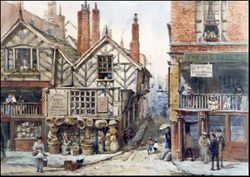

Number 32
Number 32: the rainwater head of this building is dated 1811, and the undercroft extends back over forty meters, (which makes it the longest on the rows, and possibly a surviving seld due to its extreme narrowness). The undercroft is spanned by heavy timbers which date from the 19thC rebuilding. The walls of the undercroft are, where visible, of coursed rubble sandstone and later brickwork, plastered in part. The first five chamfered oak beams are not closely datable, but are not mediaeval and probably date from the early 19thC rebuilding. Behind the 4-storey portion is an inserted concrete flat roof on the medieval walls, behind which the sandstone side walls continue, barrel-vaulted in brick in the 18thC, to the sandstone rear wall. A cottage at the rear contains an early 18thC staircase and panelled room.
Number 34
Number 34 probably dates from the 1770s. There are no external features of casual interest.
Number 36
Number 36 (once "Shuttleworth's Crypt") has a flight of 10 repaired steps to the Row and the rear wall of the Row had (it has now gone) a probably 16thC impressively studded 5-board door on wrought-iron long hinges under a 18thC blocked fanlight with architrave, cornice and key of timber. This door (now replaced with a glass door) previously opened to a passage leading through the house (see OS map of 1875).
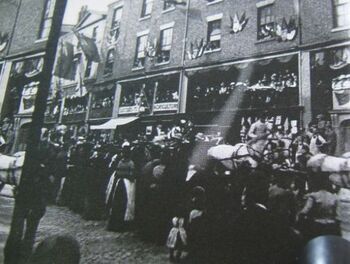
The undercroft is early to mid C14. The present floor, 3 steps below pavement level, is inserted with the lower part of the undercroft beneath. The walls are of squared sandstone rubble with some C17 and C20 brickwork. From the front there are 3 oak beams parallel with the street and 2 altered or renewed beams, then an impressive double-chamfered full-width 2-centre sandstone arch, a beam of large scantling, a second sandstone arch detailed as the first arch, a chamfered beam on stone corbels, a small C18 brick barrel-vault and sandstone rear walls. 2 bays of the ceiling have broad oak joists, the other bays where visible largely narrower joists. Beyond the rear arch the joists support visible rubble infill. In the cellar a beam used to be dated 1593 (it has since been removed), but was probably repositioned there from an upper storey when the house was refronted 18thC. Internally, a largely intact late 16thC timber frame building hides behind the late 18thC brick facade. Much of the c1600 timber frame is visible in the third storey. The fourth storey is lined and partitioned but the form of the roof and the position of partitions suggests that the timber framing may largely be intact. Tree-ring data shows that several of the beams in the undercroft were growing between 1073 and 1317. Rayner's watercolour (above) shows that the plain bressumer was once supported by a pair of "Tuscan" columns, presumably of iron like the ones next door, these have also been absent for some time.
Number 38
A watercolour by Louise Raynor shows the earlier pair of building which stood on this corner. This can be dated to after 1869 as the Town Hall has been completed. These were once occupied by the chemist and druggist James Hampson Spencer an early photographer. Around 1876 James and his mother moved from near Bury to 36 Bridge Street, Chester, Cheshire, where James took over the druggist shop of one Samuel Mather Webster (1816-1889) and settled as a chemist and druggist. By August 1878 he was advertising in the local press his Rubharb, Ginger and Dandelion Pills, his Iodized Sarsaparilla, with Iron and Quinine, his Chlorodyne Emulsion, and his Chloraline, "one of the most valuable preparations known for Toothache, Tic Doloreux, Neuralgia, Rheumastism, and all Nerve Pains". James Hampson Spencer became interested in stereoscopic photography and was a member and the secretary of the photographic section of the Chester Society of Natural Science, based at the Grosvenor Museum. Spencer used to advertise that darkroom facilites were "available to purchasers" and one of his own stereo photographs shows the shopfront on the corner od Peirpoint Lane was shuttered, possibly indicating that this was where the darkroom was located, although directories place another photographer (Joseph Brandenbourg) there. His obituary in the Liverpool Daily Post stresses his interest in stereoscopy and his skills as a stereo photographer at a time when most stereoviews available on the market were produced in the United States.
- DEATH OF A DISTINGUISHED PHOTOGRAPHER: The death is greatly lamented amongst a large circle of friends and scientists in Chester and North Wales of Mr. J. H. Spencer, who had carried on the business of chemist for a period of twenty-five years in Bridge Street, Chester. Mr. Spencer, who died on Sunday, had been suffering from a painful malady for some months past. Deceased, who leaves a widow and two children, was specially distinguished for his extraordinary ability in producing interesting photographs, more especially stereoscopic views, in which he has done some of the most remarkable work that has yet been witnessed in Great Britain. For such work he has been awarded gold and other medals at various occasions, and on one occasion he was fortunate enough to secure a handsome photograph of the present King and Queen, Mr. and Mrs. Gladstone, and the Duke and Duchess of Westminster, at Hawarden Castle. This was considered a unique and really exquisite series, which earned for him the commendation of connoisseurs of stereoscopic and other photography. He was closely identified with the photograph section of the Chester Science Society, and was equally interested in the work which tended to further scientific pursuits in connection with the Grosvenor Museum, Chester.
Number 38 was extensively renovated 1897, by Douglas and Fordham for the 1st Duke of Westminster in the Vernacular Revival style, and later altered again when it became a bank (it later ceased to be a bank). The asymmetric building is of pale yellow sandstone, stone-dressed brick and timber frame with plaster panels, with the south pier canted at the corner of Pierpoint Lane. The Row front of three basket arches has carved balusters, moulded handrail, carved timber pilasters against the end piers and two carved posts. This is one of the very few "new" buildings by Douglas to incorporate parts of the rows (see Number 30 above). The jettied close-studded third storey has its bressumer on ornate corner-bracket with carved-head corbel and mock-gargoyles at the caps of the posts. The front has two canted six-light oriels and a gable-end with a concave timber-framed apron, 2 transoms, trefoil heads to upper lights and leaded glazing. The short north bay has a three-light trefoil-headed leaded casement. The jettied gable has a carved cambered tie-beam dated 1897 on six shaped brackets, herringbone struts and shaped and pierced bargeboards.
- Number 38 on Wikpedia;
Upper Bridge Street West: Pierpoint Lane to Whitefriars
Pierpoint Lane, is named after the family of Pierrepont which in the 13th century produced a sheriff of the city and an abbess of the Benedictine nunnery. A lane leading from Bridge Street to the land of Robert Pierrepont was in being by the time of Abbot Birchills (1291-1323) and probably by the 1290s. It is to be identified with that named after an unidentified sheriff Richard, where in the later 13th century the Arneway family owned property including a chapel (probably that which earlier belonged to Alexander Harre). The lane also appears in the Assembly Book survey where it was described as 'the way some time to the common hall', an indication that it probably extended no further west than that building.
Number 40
Number 40 is a Tudor style building of 1858 designed by James Harrison and built, in loose Gothic Revival style for Welsby's wine merchants. A projecting porch, to the north, and a shaped timber bracket, to the south, support a projecting balcony in front of the Row walk. The third storey has a stone-corbelled four-light canted oriel with four-pane sashes in shoulder-arched lights and a hipped lead roof. The fourth storey has a moulded band beneath the flush sill of a triple sash with arched heads. The Builder v.16 p.269, April 17 1858 reported on this site:
- "In excavating for new buildings opposite the Feathers Inn, several bases of Roman character have been discovered at a depth of 4 feet below the surface. They are in their original positions, forming a colonnade, placed four yards apart, resting on large blocks of stone 12 inches thick. The new building will be of brick, with white stone dressings, in the medieval style of fourteenth century, presenting a gable to the street, and having a projecting bow-window to the room over the Row. A shop in Bridge Street Row is also to have timber work characteristic of Chester in the fourteenth century. Mr. Harrison is architect to both buildings."
Ghost
In the cellars is ghostly ‘George’. He has been seen by the staff of a travel agency occupying the ground floor.
Number 42
Number 42 is an undercroft and town house that was rebuilt c1720, extended to rear and refaced to Bridge Street in sandstone and brick c1860. No early fabric is retained in the lower part of the building, but the listing record states that the upper floors retain a staircase, paneling and plasterwork of an early 18thC character.
Number 44
Number 44 is an undercroft and town house rebuilt probably late C19 as an extension to the then department store ("Owen Owen", which finally closed its doors in 1999) comprising Nos.44, 46, 48 and 50. There are few interesting features other than the cast-iron columns behind the modern shopfront which continue upwards at row level as two cast-iron Doric columns.
Number 46
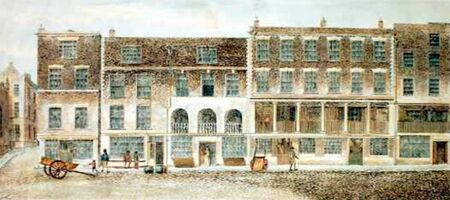
Number 46 an undercroft and town house, probably 1760s, demolished for redevelopment as part of a department store late 19thC. Facade of third and fourth storeys is a close facsimile of the Georgian front (although the column arrangement at Row level differs). Behind the facade, the then department store (Richard Jones and later Owen Owen until 1999) removed all traces of any earlier structure.
The firm of Richard Jones and Company Ltd., drapers and furnishers of 11-13 Eastgate Street and 44-46 Bridge Street, Chester, originated in a clothing business, which was started in the late 19th century by Richard Jones, draper. In Morris and Company's. Directory and Gazetteer of Cheshire, 1874, Richard Jones is described as 'draper, silk mercer, hosier and haberdasher' of 52, 54 and 56 Bridge Street, while the 1878 Post Office Directory of Cheshire, refers to Richard Jones, 'draper and mourning warehouse'. By the 1890s, the business had expanded to include home furnishing, which led to the acquisition of premises in Eastgate Street. Richard Jones and Company Ltd. subsequently became one of Chester's leading department stores, selling a wide variety of household goods and clothing at their two shops in Bridge Street and Eastgate Street. The firm also operated a removal service. In the mid 1960s, the firm was taken over by Owen Owen Ltd. The Owen Owen Food Hall formerly known as William Jones (the Three Old Arches store), was a separate business, and then amalgamated into the one store.
Numbers 48-52 (Three Old Arches)
Numbers 48-52 the "Listed Buildings" listing for this entry includes: No.2 Whitefriars: an undercroft and town house, on the site of the service wing of a large medieval town house whose hall was in Nos 48 & 50 Bridge Street. Together, these formed the largest known Rows building. The earliest fabric is the "three old arches" facade (marked "1274AD"), which date stylistically to the thirteenth century.
During the early or mid fourteenth century numbers 48-50 appear to have been combined with the property to the south to allow the construction of a major mansion with a hall that was parallel with the rows. This hall (12.4 by 8.88 meters) is the largest surviving on the Rows. The hall at row level (now a shop) is impressive, extends to row +1 level and has an east wall which contains four mediaeval doorways. A 1970's restoration of the east wall has not disguised the location of the screeen partition. The hall also contains a 16th century open fireplace with a 19th century cast iron range.
The cellar to No.52 Bridge Street, is rock-cut, largely Georgian with Flemish bond brickwork, but has some medieval stonework in the rear wall. The basement of No.2 White Friars at former undercroft level is largely Georgian with brick barrel-vaults and a brick-arched wine-bin. Of the other 14thC undercrofts only number 50 has retained its spanning arch.
Numbers 50 and 52 are the only examples of Row enclosures in Upper Bridge Street and are tentatively believed to have been enclosed in 1697, when Alderman Francis Skellern (who had been Mayor of Chester in 1689-90) was granted permission to enclose the Row. However, while Batenham's illustratiom shows that the Row was indeed enclosed at this point, the 70's restoration re-created the Row (with liberal use of reproduction reclaimed brick) at Number 50.
- Three Old Arches on Wikipedia;
Upper Bridge Street East - High Cross to Pepper Street
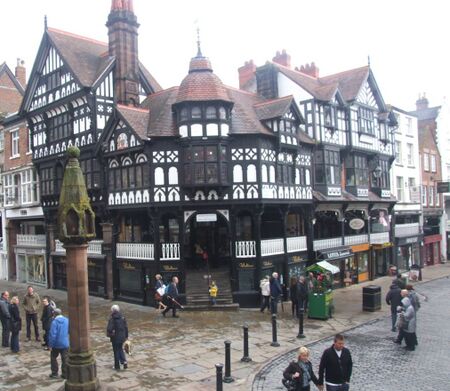
Number 1
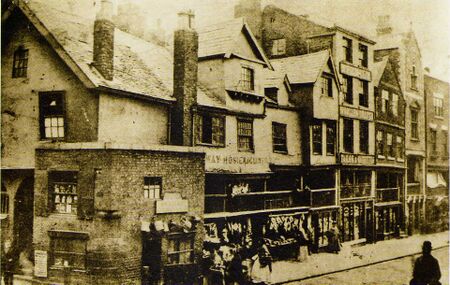
Number 1 This 1888 Vernacular Revival building is by T. M. Lockwood. Often said to be for the 1st Duke of Westminster, but already owned in 1889 by Chester City Council. It replaces a timber-framed building which incorporated the 16thC cistern, which was itself at some point replaced by a brick building.
About the year 1300 water was taken from a spring at Christleton known as the 'Abbot's Well' and conveyed by earthenware pipes installed by monks under a patent granted by Edward the First, to cisterns situated at Boughton and in the cloisters of the Monastery (now the Cathedral). In 1537, Doctor Wall (the last warden of the Franciscans) began the building of lead conduits at Boughton for conveying water to the Bridge Gate. A more northerly line for Walls pipework would have been necessary to supply the friary, and Wall perhaps changed the line of the aqueduct when he knew that the friary was to be dissolved. It came to be used as a public supply, but did not meet all the town's needs.
A well sunk in Northgate Street in 1572 did not find water, and in 1573 the then mayor, Richard Dutton, brought an unnamed workman from London to build a conduit from the Dee to the High Cross.

By 1574 the plan had been altered: the corporation gave a contract to Peter Morris (or Maurice, possibly even Maurits) to excavate a spring at St. Giles's well in Spital Boughton (near St Giles Cemetery) and convey the water in lead pipes to St Bridget's church. Morris was almost certainly Dutton's contractor of the previous year, for a Dutch hydraulic engineer of that name was active in London in the 1580s. A more effective attempt to alter Wall's conduit was made in 1583, when the Assembly decided to have it realigned along Foregate Street and Eastgate Street to a cistern at the High Cross on the corner of Bridge Street. The site was chosen by four benefactors of the scheme, the three Offley brothers and John Rogers of London. A stone cistern house was decorated with the arms of the city, the earls of Derby and Leicester, one of the Offleys, and Dr. Wall. The pipes were lead.
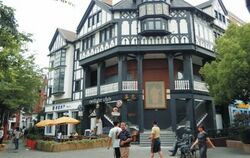
By 1586 the scheme was causing problems: the spring did not provide enough water and the mason had overspent. To produce a better supply other springs were diverted to the head of the conduit, work paid for by a voluntary subscription and mostly completed in 1586–7. It included a well house at Boughton, where the flow was turned on at five every morning and again between four and five in the afternoon to fill the cistern. After describing the Tyrer waterworks by the Old Dee Bridge, Hemingway writes:
- Possibly these did not answer their purpose effectually for in 1622 Tyrer had a new grant of a tower erected for a water work and a well place ten feet square near Spittle Boughton with full power for the conveyance of water to a cistern or conduit near the high cross. - see also ZCHD/1/13, 13 September 1622.
Several images of the cistern building survive from prior to Lockwood's building, there is a photograph from around 1860, and the cistern building sometimes edges into the works of Louise Rayner. There is also a detailed illustration in Batenham's engraved version of "Streetview". The oldest surviving depiction is a line drawing from Randle Holme.
Research by a local historian has revealed that the Hosier and Glover whose shop is visible in early photographs was "W. Conway" who sold "shirts, collars, neckties and handkerchiefs". In 1874 the business was purchased by a John Wild, and a description of his business suggests that it was actually established by a Foulkes (see: Castle Street} in 1755. In intervening years, in 1790, this was the site of the premises where Susannah Towsey started her Millinery Haberdashery and Glover business which was later to develop into Brown's of Chester. Later still the premises were occupied by hosier and glover Stanley Edwards from 1900-02 and by 1912 it was still a clothes shop, run by the Cochranes, which still maintained a "Belfast Shirt and Collar Depot". Their business lasted until around 1979. The connection with Chester's traditional trades is a clear illustration of onetime importance of gloves and linen to the economy of the city. Gloves, gave their name to the "Gloverstone" and a glove was hung opposite from the parapet of St Peter during the fairs. Many of the skins for the manufacture of gloves were imported from Ireland (see: Tanning) - and gloves were manufactured her as importing them was actually illegal. Linen was also a major trade item, being at times the greatest share of the goods traded at the city fairs. By the 1780's the trade reached its maximum with some five and a half million yards (over 3,000 miles) being imported. The first Linenhall had opened off Northgate Street in the 1740's, and a second, much larger Linenhall opened in 1778. However trade fell off equally quickly as English merchants becan to deal directly with the Irish, the Belfast-Liverpool route grew in importance over the Dublin-Chester route, cotton became cheaper and the River Dee continued to silt. By the 1830's the Linen trade was all but dead and even at it's peak the trade could not have done more than enrich a few rather rather than provide any lasting industry. However, trade in linen and goods clearly persisted at the Cross until relatively recently.
The present building has one bay towards Bridge Street, a canted corner with an octagonal tourelle and one bay towards Eastgate Street. There are seven stone steps to the Row at the corner under a round timber arch. The third storey bressumer has a patterned fascia; 3 rows of plaster panels, the lower with central decorative features and arched braces, the middle row with round-arched heads and the upper row with ornate quadrant braces. The corner turret has 3 good pargeted panels beneath a mullioned canted casement and its two-stage curved tourelle roof is capped with a wind-vane. This is said to be the best liked of Lockwood's buildings in Chester, and well executed in his most flamboyant style. The image of the building has been reproduced on postage stamps and small pottery models of it have made for sale. Photographs of it are used on the cover of many books relating to Chester.
Perhaps the strangest thing about this building is that a "Chinese Copy" of it exists. In Songjiang New City, a satellite city about twenty miles from Shanghai, among nine themed districts is an "English Area" known as "Thames Town" which was completed in 2006 and designed by the architects WS Atkins. It contains a nightclub - the "Twilight Club" - which is a chinese copy of Lockwood's building.
- 1 Bridge Street on Wikpedia;
Numbers 3 to 7
Numbers 3-7 comprises three undercrofts with some medival asonry surviving at the rear and row shops above rebuilt 1889-90 in a Vernacular Revival style by WM Boden to replace the three bays seen in the old photograph above. The row front has brick end-piers, two intermediate supports (probably cast-iron) in square wooden cases with moulded capitals, a boarded sloped stallboard about 2m from front to back and a boarded Row walk. Shaped brackets support a tiled lean-to roof intersecting three canted five-light mullioned oriels with concave sub-panels and leaded glazing above their transoms. Four further large shaped brackets support the jettied fourth storey of which the projecting central bay has a four-light mock oriel. There are shallow three-light canted oriels in each side-bay, each under a gablet with a pair of curved braces. The undercrofts have 4, 5 and 4 steps down from street at numbers.3, 5 and 7 respectively. the interiors are lined. On September 16 1889, prior to sending drawings October 21 1889 to the City Council, the builder wrote:
- "...The old premises were constructed of [timber] and plaster about 4in. thick and, as space is very valuable, I propose to build all the partitions of 4.1/2in. Ruabon pressed bricks and hoop iron bands, using freely cast-iron joists and girders resting on strong pillars. The front wall below timber framing 9 in. thick and all basement walls 9 in. When approved you can have copies for your use Yours very faithfully William M. Boden"
Number 9
Number 9 has a rendered brick facade of around 1840 which conceals a building which was a medieval undercroft below a town house substantially rebuilt c1700. Externally there are sandstone end piers continuous through undercroft and Row storeys. The row has a cast-iron railing to the Row front with ornate spear-heads, a cast-iron central column a boarded sloped stallboard a little over 2m deep, and flagged Row walk. Above that is rendered brick. In the undercroft most surfaces are lined, but some medieval stonework is visible in the rear wall, with a cloakroom having sandstone walls and a chamber on the routh side 4.33m deep being also of sandstone. At row level +1 there are 17thC chamfered cross-beams with lambs tongue stops and some fleur-de-lys plasterwork at the ceiling corners. An open-well closed-string oak stair to the fourth and fifth storeys appears of early date and the fifth storey has a painted oak door of 7 roughly-fielded panels, probably late C17, to the front room which has a stone fireplace and mantel. There are signs that this building was once jettied, but that the jetty was removed at some stage, possibly when the building was refaced in c1840.
Number 11
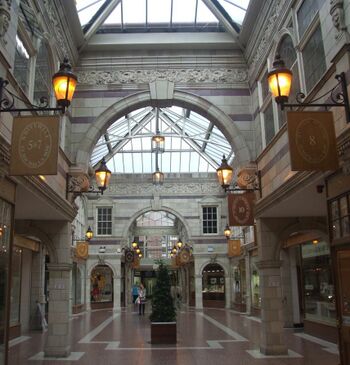
Number 11 Is another partially surviving 17thC timber framed building with a mediaval undercroft that has been re-fronted. The upper part of the facade was rebuilt as a replica in the 2othC. Outside there is a flight of ten sandstone steps to the Row, sandstone end piers through undercroft and Row storeys, a plain timber rail on simply moulded balusters to Row front and return to steps, two cast-iron intermediate columns, and a sloped boarded stallboard 2.0m deep. The front to the third and fourth storeys is rebuilt in C20 brick, but approximately in its C17-C18 form. Within, a 18thC brick cross-wall divides the front and back parts of the undercroft. The front part, now a small shop, has a central oak chamfered "samson post" 0.37m square, the chamfers stopped at top but not bottom, with a heavy oak pad carrying a beam 0.45m wide by 0.21m high, running from front to back. This Samson Post appears to have once been one of a pair. In the rear part of the undercroft, reached by C18 stone steps from the Row-level shop, the beam has been cut off, but the medieval sandstone side-walls, the patched rear wall with a corbel formerly carrying the beam and a timber sole-plate in the north wall, level with the former beam, are visible - and there is no Samson Post.
The "mask" of a winking devil which was once located at one end of the street level shop sign was one of the "Imps" on the "Chester Imp Trail". There is still an identical "imp" on the Castle Street wall of the Olde King's Head further down Bridge Street.
The Row shop (Lowe and Sons - an easy to miss, rather upmarket, silversmith) has an intact Edwardian hardwood interior - the best example of its period in Chester, with a stair to an arcaded gallery at third storey level, having tapered square posts, with entasis, round arches and triple keys. This gallery probably reflects the 17thC arrangement. There is a probably 17thC chamfered oak beam across shop and rear passage. The chamber above the Row has a C17 beam morticed for a former stud partition. The rear wing, east, has Georgian brickwork and a Georgian window. A narrow stair leads to the altered fourth storey which has some oak studding, wattle-and-daub and an exposed 17thC trenched-purlin roof truss. It's often been said that it's the oldest store still trading in Chester city centre (that is about to change - see below).
Lowe and Sons was founded in Chester by the first George Lowe in 1770 and has occupied the premises in Bridge Street Row since 1804. Harold Lowe, a grandson of George Lowe of Chester, was fifth officer on the Titanic and one of the heroes of its sinking in 1912. Harold Lowe grew up in Barmouth where his father ran a branch of Lowe and Sons and was a regular visitor to the Chester store, then owned by his uncle. Harold did have the opportunity to join the family business but instead chose to run away to sea. Lowe is not the only connection between Chester and the doomed ship: William Wynn, a surviving deckhand, was born in Chester; Lilian, daughter of Thomas Hughes perished in the sinking; and, the ship which accompanied the Carpathia to New York was USS Chester.
In 2018, 248-year-old Lowe and Sons announced that it would close in April when the lease expired. The store, known for unique Chester silverware and vintage bespoke jewellery, has been trading since 1770 and been in its current Bridge Street Row premises since 1804. In October 2018 it was suggested that Lowes would re-open under the mangement of Powell's Fine Jewellery on Eastgate Street.
- Harold Lowe and his connection with Chester;
- The Lowe family;
- some more on Titanic;
Number 13
Number 13 was designed in 1861, in the Tudor Revival style by Edward Hodkinson, for Mr Ewen, a hosier. The heavy Row-front balustrade has a moulded timber rail on spiral-moulded balusters and half-octagon responds which carry a possibly reused C17 chamfered bressumer on quadrant brackets with mouchettes in spandrels and end-pendants. The upper storeys are painted stone-dressed brick, with a stone mullioned and transomed window on the third storey having a pediment above the lintel. There is a a stepped 3-light mullioned window to the fourth storey, which has a transom and upper light to the central portion only. A recessed stone panel is dated 1861. There is a moulded stone cornice to the front gable. Inside, there is no evidence of earlier fabric.

Number 15
Number 15 is another example of an 18thC brick facade concealing a 17thC timber framed structure. Outside there are eleven steps to Row by the south pier which is of sandstone. The north pier is covered. Cast-iron railings run across the row front and the return to the steps has circlets between paired upper rails. There is a slender moulded central cast-iron column with a second column behind. The stall-board is 1.7m deep and flat. There are 2 early to mid C14 double-chamfered bluntly-pointed cross arches of sandstone carrying medieval flat oak joists in the undercroft. Some 17thC plasterwork survives on the upper floors and the way that this has been truncated indicates that the building was originally jettied. The passage to the rear wing has a stone and brick stair, north, to a small cellar which is barrel-vaulted in brick and probably 18thC.
Number #15 is the most likely former site of the "Blue Posts", where Elizabeth Mottershead did her famous trick with the cards.
Numbers 17 and 19

Numbers 17 & 19 is a rendered brick building rebuilt late 18thC as undercroft shop, Row shop and accommodation. The cellar behind reached from the Row shop has medieval sandstone sidewalls. The now plain facade has been altered since it was originally constructed, having lost heavy cornices and brackets and a projecting pediment.
Number 21
Number 21 has an early 19thC brick facade. The undercroft ceiling and probably side-walls medieval, most likely 14thC, whereas the front and probably interior of upper storeys is from c1800. The narrow undercroft has a chamfered oak beam under back of the stallboard, stopped at the south end.
Number 23
Number 23 is an early 19thC brick building with cast-iron Roman Doric columns at row level, and a medieval undercroft.
Numbers 25-27
Numbers 25-27 has a front which dates from c1800, but inside only the undercroft is of that date the rest of the building having been altered in the 1930s for newspaper printing premises. office front to street. All four windows on the upper floors are different and include an inserted 5-light large-pane mullioned and transomed canted oriel. The undercroft, lowered and altered for newspaper press, has 2 cast-iron Roman Doric columns, timber beams and joists.
Number 29
Number 29 is a brick building from about 1800 with cast iron Doric columns at the row level. The site of any medieval undercroft is largely obliterated by a vast subterranean printing press room.
Numbers 31-35
St Micheal's Row is a large Vernacular Revival steel framed building of 1909-11 with a half-timbered facade designed by W. T. Lockwood, for the second Duke of Westminster. It replaces a similar scaled (but four bay) building of 1863 by Edward Hodkinson, and incorporates the row level entrance to St Michael's Arcade. The Row shops flank a pilastered, segmental archway with "figurehead" corbels, one a female, the other a bearded male. The frontage takes the form of a symmetrical, "E-shaped", late Elizabethan house, jettied (slightly) at each storey. The almost level stallboards and the Row walk are paved in terrazzo. The shopfronts to each side of the arcade have recessed doors in basket arches with Art Nouveau carvings.
Prior to Hodkinson's changes, this was the site of "The Feathers" Hotel, as can be seen in the uppermost old photograph on the right. "Feathers Lane", a narrow alleyway a litle further down Bridge Street at Number 49, survives today and originally led to the stables behind this ancient inn. In 1658, the will of Thomas Heath left the land to his wife:
- "my wife Anne Heath to have my messuage situate in Bridge-street in Chester called The Plume of Feathers, now in the possession of Edward Burrowes, innholder".
The shopping arcade was introduced to England by John Nash from Paris, making its first appearance at London’s Royal Opera Arcade of 1816-18; London’s Burlington Arcade, perhaps the best known of all, followed in 1818. Arcades created vibrant commercial thoroughfares, architecturally united by means of repeated shop units lining covered and top-lit walkways. They gained a new lease of life through cast iron building technology. This enabled larger, more elaborate, designs to be realised.
W. T. and P.H. Lockwood (who had taken over their father's practice) originally intended that this large and ambitious project should be wholly faced in white and gold Doulton faience tiles. Plans for the redevelopment came before the Improvement Committee in June 1909. The scheme was approved, but noting that the front was of faience tiles the Improvement Committee instructed the Town Clerk to write to the Duke and suggest that it might be changed to half-timbering "in harmony with the characteristic architecture of the city". Other petitions to the Duke came from the Bishop of Chester and the Archaeological Society. Initially the Duke took no notice other than to explain that the half-timbered front would need repainting every three years at some expense (£150 in 1909 money).
The "White City" as it was known locally had barely reached its full height in September 1910 when a debate erupted in the "letters" pages of the local newspaper (the Chester Chronicle). Only James Williams, a member of the Archaeological Society appeared unopposed to it. Williams wrote:
- "..when we see the truly cosmopolitan styles of architecture now so general, we may congratulate ourselves upon the varied styles used in the buildings in Chester. What sort of a place would it look like if only one style or architecture was adopted? We should be appalled with the sameness. In our antiquarian researches let us not ourselves become antiquated. Whilst preserving the ancient - the old features - let us use the new styles also, and prosperity will bless us".
The majority remained opposed to this deviation from the "Chester Look" and the 2nd duke of Westminster was sensitive to the criticism and decided, at his own expense, to have the tiles removed and replaced by the timber frontage seen today, which the Duke paid (£4000) to have erected. There are very few surviving photographs of the "tiled" building as it (briefly) was, but one of them is reproduced below. The alterations were greeted enthusiastically by the Improvement Committee and the Chronicle. In addition to removing the tiles, an extra bay was added to each side and the building was made taller (involving the demolition of two further properties). Work on the changes started towards the end of March 1911 and was completed in August. The tiles were advertised for sale in the Chronicle, but it is not known what their eventual fate was.
St Michael's Row
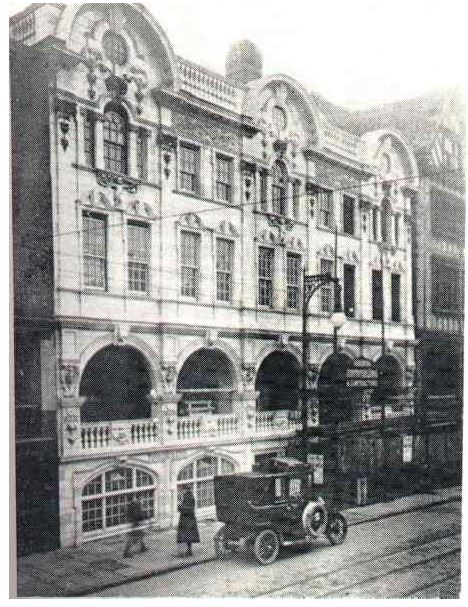
Numbers 37-41
Numbers 37-41 are a Neo-Jacobean style building errected in 1864 for the second Marquis of Westminster and designed by Edward Hodkinson. Above the row level this is brown brick diapered in blue and stone-dressed. The central gable is slightly larger than those to each side, and all three gables are stone-dressed, with kneelers, rectangular side-projections, copings and a stumpy octagonal finial. The real interest is in the late 13th-early 14thC undercroft which would have originally have been some 4.2 meters high prior to a street-level floor being inserted in 1864.
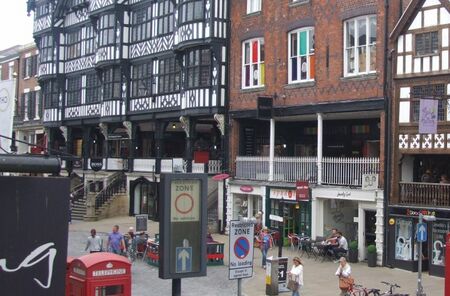
Batenham (1827) writes:
- "A few paces onward we arrive at the Feathers Inn the site of a Roman building of some importance. To the antiquary and connoisseur this place possesses great interest for here are preserved in a tolerably perfect state, the remains of one of their hypocausts and of a sweating bath much in use among the Romans as a surperlative luxury. As any description must fall short of givings correct idea of this curious contrivance we must recommend an inspection besides which our limits will not admit of a minute notice of every remarkable object otherwise we might fail in our ostensible purpose of pointing out where they are to be found."
Seacome writes (1828) of this:
- "At the back of a smith's shop, in a cellar near the Plume of Feathers Inn, are the remains of a Roman Hypocaust, fifteen feet long and eight wide, with an adjoining chamber or praefurnium of the same dimensions. This Hypocaust is supported by twenty eight square pillars, two feet eight inches high, and one foot square at the top and bottom. Over these pillars are placed bricks eighteen inches square, and three inches thick, which support others two feet square, perforated with small holes about six inches asunder. Immediately over this uppermost layer of bricks, is a terrace floor composed of several layers of lime, pounded bricks, &c. in different proportion and degrees of fineness."
The west cellar wall contains Roman bath-house masonry and an opening through the north wall, towards the east end, leads down 8 steps, now concrete, to the undercroft formerly at rear of No.37 Street, with floor and lower walls of bedrock. Towards the north a rock-cut sump, probably medieval, fed with water, which has a timber rail on column-on-vase balusters, probably from 1864. A rebated medieval doorway, east, leads to remains of a Roman hypocaust, perhaps restored when found during redevelopment in 1864. There are 27 surviving square, waisted columns in a rectangular chamber formerly containing 4 rows of 8 columns. A large 4-course stone compound corbel and a smaller corbel visible to each side in the east wall, probably dating from about 1300.
Hughes writes (1858) as follows:
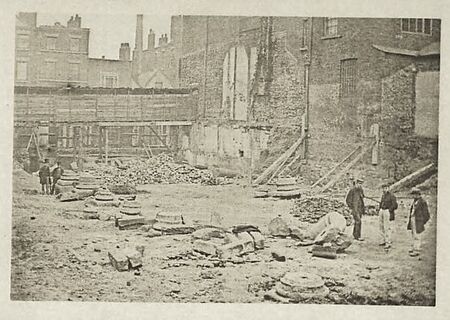
- "Scarcely so far down as this last named lane and on the opposite side of Bridge Street is a new and handsome range of buildings erected in 1853 by Mr Alderman Royle On the higher side of these premises and adjoining the Feathers Hotel exist a Roman Hypocaust and Sweating Bath of surpassing interest and in a state almost as perfect as when first erected. The following recount of this ancient of days is the result of a recent personal visit to the bath. It consists of two rooms considerably below the present level of the street the first being fifteen feet long eight feet wide and about six and a half feet deep. The Hypocaust is of rectangular shape about the same size but except at the entrance not more than half as deep as the first chamber. It was originally supported by thirty two square pillars two and a half feet high and one foot in diameter at top and bottom twenty eight of these pillars still remain. Brick tiles eighteen inches square and three inches thick surmount these pillars and over these are placed tiles two feet square perforated here and there with small holes through which the heat ascended to the sweating chamber above. The sweating room or Sudatory was immediately over the Hypocaust and was fitted with seats for the bathers who soon found themselves in a hot perspiration. They were then scraped carefully with an instrument constructed for the purpose or else plunged into a cold water bath after which they were rubbed down with towels anointed with fresh oil and then repaired to the tiring room there they dressed themselves deposited their denarii for the attendants and then went their way having enjoyed a luxury which few but Romans had then learned to indulge in. As we have before stated the buildings above and around have been only recently rebuilt but Messrs Royle the proprietors with that antiquarian zeal and true public spirit which have ever distinguished them took especial precautions to preserve both from injury and molestation this curious relic of proud old Rome. Since the adjacent premises have been rebuilt the bath is much easier of access than it was before and visitors can now inspect these remains without any personal sacrifice either of cleanliness or comfort"
Across a rear court are some of the few surviving "courtyard tenement" buildings in Chester.
- The Hypocaust at Pastscape.
St Michael's Rectory (43)
St Michael's Rectory is a mid 17thC half-timbered building which was built in 1659 and later bequeathed, in 1709, by Lettice Whitley to St Michael's Parish. Prior to this the parsonage was a small room over the west porch of the church of St Michael. It remained (at times a bookshop, and for a while A. W. Plaistow's "Bijou Bazaar") in church ownership until 1907 when it was sold to a Mr G. H. Crawford, an antique dealer. Hemingway notes:
- Lettice Whitley left a house on the east side of Bridge street (now tenanted by Mr Swarbrick bookseller and commonly called the parsonage house) to the minister and his successors for ever and charged the cellar under the same with 10s a year for the clerk and 5s for the sexton for ever By her will in 1706 this house is left to Mr Brereton paying 4 a year to the minister but in a codicil dated July 3 1706 the minister is to have the house and the cellar only is reserved to Mr. Brereton paying the clerk and sexton which by the will lay on the premises at large.
Hemingway is off with some of his data again and it is here that things appear to become somewhat murky. Lettice's will actually refers to: "a messuage or dwelling house on the East side of Bridge Street wherein she now dwells with the shop of cellar underneath to her nephew Robert Brerewood" (Sir Robert Brerewood - the MP - not Brereton), and Pigot gets the date of codicil correct - 1708, which Hemingway gets wrong. Mr Swarbrick, a dealer in second-hand books did exist, (and was Sheriff of Chester in 1805/6) he is one of the tennants mentioned by John Lowe (see below) although whatever Lowe alludes to about him has been forgotten.
According to the Chirk Castle Accounts 1666-1753, Lettice Whitley was the wife of Ralph Whitley and daughter of "Henry" Gamul, although other records show her as the daughter of Francis Gamul of Gamul House. She died without issue and was buried (7th April 1709) at St Mary on the Hill in Chester (the church register gives her address as "Peper Sreet"). Ralph Whitley was the son of Welshman Thomas Whitley and a younger brother of Roger Whitley (?1618-97), MP for Chester. Lettice is frequently mentioned in Roger's diaries (see for example 7th October 1690). It appears that she married three times (first to a James Harleston, then to a Gilbert Houghton, and finaly to Ralph Whitley) and survived all three husbands.
Turning to the building, continuous oak corner-posts extend through the Row and third storeys and consoles on these corner-posts carry an ovolo bressumer. The small-framed third storey has a row of 5 ornamented panels which are absent in earlier photographs (see photographs above), and neither the three-light mullioned and transomed leaded casement on the row +1 floor nor the leaded 3-light casement above that seem original. In the Row and upper storeys 17thC features include the front wall, the former rear wall now forming an internal cross-wall, a fine but incomplete moulded plaster ceiling and the form of the galleried hall open to the roof. The building presents the interesting puzzle that early photographs (see above) shopw a brick-fronted building at this location.
A photograph of the building from around 1900 shows it to have beeen the "Bijou Bazaar" of A. W. Plaistow, seller of "Ornaments and Crasses". "Crasses" might be read as "Grasses" as the Victorians had something of an obsession with ornamental ferns and other non-flowering plants. This became so extreme that Charles Kingsley coined the term "Pteridomania".
Reordering of the interior, difficult to identify completely, was undertaken by Crawford shortly after 1907. The former rear wall to the third storey is now an interior wall with has a 6-light mullioned and transomed leaded casement. Beneath the casement three 19thC "carved" panels in the manner of late Middle Ages depicting scences of the crucifiction and deposition, probably brought in and inserted by Crawford shortly after 1907 (they may be plaster casts - and possibly a left-over from Mr Plaistow) - Crawford appears to be the same Crawford who aquired the "squint" from Leche House (which appears to have mysteriously returned). The balustrade of the east cross-landing of the galleried hall carries three further stations of the Cross panels. The purlin roof is 17thC, but is much altered.
In 2014 the building housed the award-winning "Mad Hatter's" tea-rooms - now sadly closed. Their website featured further photographs of the interior and notes some of the history of the building, as well as the fact that Lewis Carroll (Charles Dodgson) was born in the parsonage of Daresbury in Cheshire, not too far from Chester.
Numbers 45-47
Numbers 45-47 were until recently a fine early 20thC butchers shop in a brick building (probably those built in 1853 by alderman Royle). The third storey has an altered inserted canted barge-pane timber oriel. No evidence of earlier fabric. "Venables" butchers was one of the last few "traditional" independent family-owned shops in the City center, but closed around 2012.
Number 49

Number 49 is a Vernacular Revival building by W. M. Boden, dated 1891 on the gable tie-beam and in a similar style to his 2-7 Upper Bridge Street. At street level there is a modern shopfront with a covered entry to Feathers Lane. The row walk is quarry tiled and includes a bridge over Feathers Lane. The row-top bressumer sits on shaped brackets. A hipped lean-to roof on ornate brackets projects beneath an entry-bay cross casement and intersects a six-light canted oriel on the main bay - this is similar to his design at numbers 2-7. The timber-framed fourth storey, flush over the entry, is boldly jettied on shaped brackets in the main bay, there is a row of ornate small panels across both bays, a 2-pane casement standing proud on brackets over the entry and a six-light square oriel on the main bay. A coved jetty supports the main-bay front gable which has a tie-beam (inscribed 1891), S-curved herringbone struts and moulded bargeboards. The 1891 interior has be largely removed with only a single late 19thC cornice surviving at undercroft level.
It has been suggested that the "London Bridge Hotel", which previously stood on this site, was actually simply the Bridge Hotel until 1855, took its name from the bridge over Feather's Lane, which could be raised in two halves to alow laden hay wagons into Feather's Lane. The problems with that explantion are that London's "Tower Bridge" (frequently mis-named "London Bridge") was only constructed 1886-94: by that time it appears that the "drawbridge" in Feather's Lane had been replaced by something more permanent, and, the Plume of Feather's was itself demolished about 1863-5. It is also possible that the lifting bridge never existed, as Hughes (1858) writes:
- "Lower down than the Roman Bath there was until recently a break in this Row occasioned by a narrow lane which leads up to the stables of the Feathers Hotel. This inconvenience has now been obviated by a neat wooden bridge stretching across the passage from row to row, and we can now walk along without the slightest obstruction till we come to St Michael's Church."
Numbers 51-53
numbers 51-53 have a "proto" Vernacular Revival frontage from 1858 by James Harrison, which encases a much altered 17thC timber frame building.
The third storey has a central 5-light canted oriel on a rendered corbel similarly detailed to that on No.40 Bridge Street & Row (qv); the lights have 2-pane sashes with cusped arches to heads; hipped oriel roof of slate. The timber framing is planted, with the edges of every component cusped; the centre rail to each side of the oriel has a saltire-braced panel beneath and above; the gable above the oriel has framing like an 8-spoked wheel. The ornate shaped bargeboards are each cusped and pierced with 2 pairs of mouchettes.
This building tallies with the reference to James Harrison's buildings in Bridge Street quoted from The Builder v.16 p.269, April 17 1858:
- "A shop in Bridge Street Row is also to have timber work characteristic of Chester in the fourteenth century. Mr Harrison is architect of both buildings."
The 1858 building is one of the first half-timbered revival structures in Chester. At a meeting of the 31st December 1849 the Chester and North Wales Architectual, Archaeological and Historic Society was formed and when the minutes of this first meeting were written up an circulated they were accompanied by an anonymous article entitled "Street Architecture of Chester". The author of this piece laments the replacement of timber-framed houses "with curiously carved fantastical gables" with "miserable brick and and incongruous piles of heavy Athenian architecture". The unknown writer goes on to say:
- "..that if Chester is to maintain its far famed celebrity as one of the 'wonder cities' of England, if the great European and Transatlantic continents are still to contribute their shoals of annual visitors to ill our hotels, and the not too plenteous coffers of our tradesmen, one course only is open to us. We must maintain our ancient landmarks, we must preserve inviolate our city's rare attractions, .. our quaint old Rows, unique and picturesque as they currently are, must not be idly sacrificed at Mammon's reckless shrine."
The first half-timbered revival building in The Rows was the 1852 premises of Mr Platt the chemist in Eastgate Street. In 1857, Penson's 36-38 Eastgate Street followed. James Harrison, the first architectural correspondent of the Archaeological Society, also experimented with vernacular sources, with 40 Bridge Street and as here, directly across the street at 51-53.

Number 55
Number 55 is a Vernacular Revival building by Thomas Edwards built as a commercial art gallery for David Sherratt (and, as freeholder, the first Duke of Westminster) in 1889. Edwards was in practice at No.7, St Werburgh Street as Kelly and Edwards, having taken over James Harrison's practice up his death in 1866. The half-timbered facade has inscriptions, statuary and carved panels of biblical scenes after the manner of Bishop Lloyd's House. The building appears to have 4 storeys, wheras in fact it only has three, expressed as four. Nine sandstone steps to the lead from the street to the Row. The undercroft has a modern shopfront between fluted pilasters with carved foliar bases. There are four large-scantling bridging joists in the undercroft shop and the lower part of the side walls are probably 18thC. Row and street numbers have drifted so far apart by now that the address of the Row level above number 55 would have been: "D. Sherratt & Co, 61 Bridge Street Row, Chester".
The front of the Row and upper storeys is "richly" ornamented. In fact it appears that just about everything is tried to make the property look like something that might be thought original, and the overall effect is to fail miserably. There is a heavy timber rail to Row front and return on moulded rectangular balusters. The sandstone upper parts of the end-piers have griffin capitals. Two intermediate posts have linenfold reeding. The sloped boarded stallboard is 2.23m deep. The row-top bressumer is mounted on ornate brackets; the central pair of brackets form an arch inscribed "SHERRATT & CO" in raised capitals - perhaps a big clue to Sherrat's potential customers that in the art world things are not always as they appear. The third storey is expressed externally as two storeys (clever trickery). The slightly jettied sole-plate to the "third" storey is inscribed "TO GOD MY KING AND COUNTRY" (yes, Queen Victoria (24 May 1819 – 22 January 1901) was still very much alive in 1889) and is also carved with an assortment of reptiles. How any reference to the king can have survived the Civil War and the wrecking expedition of the Parliamentarians after the fall of Chester is hard to see.
The eight arched panels above contain "biblical" reliefs inscribed:
- And departed into Egypt: - the flight into Egypt is a well known part of the Biblical story, and it is one very frequently depicted in works of art. However this brief verse is the only information the canon scriptures give to this voyage. Most of the traditions about this voyage come from the New Testament Apocrypha. Like some of the other images found in the frieze this was the subject of a painting by one of the Gentileschi's.
- In whom I am well pleased: Matthew 3:17 again often painted ... but the Greek gets a bit odd and leads to all sorts of arguments.
- SUZANNA and the ELDERS: In case you never heard of this: it is included in the Book of Daniel (as chapter 13) by the Roman Catholic and Eastern Orthodox churches. It is one of the additions to Daniel, considered apocryphal by Protestants. It is listed in Article VI of the Thirty-Nine Articles of the Church of England among the books which are included in the Bible but not for the formation of doctrine. This chapter is based on a series of Greek language puns, which tend to indicate it was originally written in Greek. It is one of the biblical scenes that was mostly painted because it involved a lot of bare flesh. One example is "Susanna and the Elders" by Gentileschi
- Joseph and his Mistress: Most paintings of this scene also involve a lot of bare flesh (as in "Joseph and Potiphar's Wife" by Gentileschi. When Orazio Gentileschi came to England in 1626 his main employer seems to have been Charles I's wife, Henrietta Maria, the daughter of Marie de' Medici, who continued to profess her Catholic faith after her marriage in 1625. For the queen Gentileschi painted the ceiling of the Great Hall in The Queen's House at Greenwich - Allegory of Peace and the Arts under the English Crown (now in Marlborough House, London) - and other important pictures by him are recorded at Greenwich such as The Finding of Moses (given by Charles I to Philip IV of Spain in 1633) and Joseph and Potiphar's Wife. This last, although sold after the king's execution in 1649, was recovered for the Royal Collection at the time of the Restoration and sent to Henrietta Maria in exile in France at Colombes.
- I call for my friends: - does not even seem to be a biblical quote, and the image, while difficult to make out seems to be a half dressed woman doing something with a devil outside a building with a sign having crossed-keys (a symbol of the pope) while a man watches from a window.
- Cain and Abel;
- Jeremiah: - in the stocks
- Praise him on the harpe - Psalm 33 (or 150)
There seems to be no sense to this particular choice of biblical symbolism, except perhaps that many, if not all, of the subjects had also been the subject of paintings. Some of these paintings are associated with the court of Charles I - such as those by Orazio Lomi Gentileschi (1563–1639), an Italian painter, born in Tuscany, who spent the last part of his life at the court of Charles I of England. He was the father of the painter Artemisia Gentileschi who was also at Charles' court and also painted works related to some of the scenes depicted on the frontage of the building.
Above the 6 central panels 5 moulded brackets support a pair of 4-light mullioned and transomed leaded oriels separated by a round-arched niche holding a life-size statue of a King Charles I with sword, gold orb, sceptre and crown. The king's figure is noticeably out of proportion with the legs being too short. It is believed that the figure was originally made taller, but that some shortening of the legs was required to make it fit the niche. Again, if someone is trying to convince people that this is an original Tudor property then it is again hard to see how those same people would not have worked-out for themselves that the strongly anti-royalist Parliamentarians would have burned any statue of King Charles (and how Charles manages, somewhat miraculously, to appear on a Tudor building purported to have been constructed long before this Stuart king was born).
The middle rail to each side of the oriels has an ornate panel below and above. The ornate jetty beam to the "fourth" storey, on carved end-brackets, is inscribed "ART GALLERY" - as if it always had been. Above this the five-light mullioned and transomed casement has pictorial leaded glazing - except the glazing clearly comes from windows of a different shape!
A large wrought-iron hanging sign dated 1889 bears a shield, now blank. The cove-jettied gable has 4 brackets, each resting on a spiral-moulded colonnette - except that on the south corner-post is gone. The framing to the gable, thinner than that below, has square panels with quadrant braces. The gable has carved bargeboards and a shaped finial.
The extent to which the 1889 design of the interior of the Row and third storey remains visible is unusual, for Chester. The Row + 1 storey forms 2 chambers of the former gallery, linked through a depressed plastered archway.
Possible explanations for the buildings "exuberant" decoration range from:
- The architect/owner were trying to pass this off as an ancient building and failed, somewhat obviously;
- It is a clever "mockery" of the rest of mock-tudor Chester - especially as many of the biblical scenes in the woodwork were painted by artists associated with Charles I.;
Modern day auction records show that D. Sherratt & Co. was a seller of fine art (including furniture) that frequently turns up with a sellers plate bearing their name and address. Sherratt & Co sold several items of antique furniture to William Hesketh Lever, 1st Lord Leverhulme during the period prior to WWI. Just exactly why they should end up with a "mockery Tudor" facade remains unknown.
- Number 55 on Pastscape.
Number 57
Number 57 is a brick built structure of the early 19thC incorporating some fragments of a 17thC timber frame building. The undercroft shop has surfaces covered and the cross-beams are boxed, but from the back a sandstone passage leads to a medieval rear undercroft 3.7m wide and 3.47m front to back, the west wall is the former rear wall of the medieval front undercroft, with masonry visible south of the doorway; a cupboard recess in the west wall. A roughly chamfered oak beam against the north wall is probably 17thC. The Row shop is lined, but with a doorway to the south passage which has a stop-chamfered cross-beam and other indications of 17thC timber framing. Some wattle is displayed on an upper floor
Number 59
Number 59 is a 17thC building, incorporating earlier fabric, with 18thC alterations and was re-fronted in the 1950's in an attempt to replicate the elevation recorded by Batenham in 1816.
Number 61

Number 61 dates, from the Row up from c1760. The front part of the undercroft, 3 steps down from the pavement, is lined, with no features visible; the back part is paired, with the south chamber under a 18thC brick barrel-vault, now plastered. Observations during refurbishment in July 1988 revealed medieval stone walls with a doorway and fair east face to the present back wall, suggesting a similar rear undercroft chamber to that in No.57. The Row storey has some reused C17 oak beams.
Number 63
Number 61 dates from c1760, with some alterations 20thC. The undercroft is lined, but has 18thC cross-beams and was observed during refurbishment to have a presumably medieval sandstone south wall, adjacent to St Michael's Church.
St Michael's Church

St Michael's Church is decribed by Batenham as follows:
- "About a hundred yards lower at the corner of Pepper street is St Michael's Church, the porch of which is much admired for its architectural symmetry the interior is neat and convenient and boasts a handsome roof in the antique style. There are two small galleries added but the injudicious and unwholsome practice of interment in the church has undermined their supporters so as to render their security rather doubtful. The well proportioned tower steeple of this church is about seventy feet high and contains six bells. Exactly opposite to this stands St Bridget's Church of very early date being supposed to have been founded by 0ffa the Saxon prince in the eighth century. It has recently been suggested to remove this church to a more eligible situation as its present projection is a great inconvenience besides being unsightly. In this event a new street would be opened in a line with the castle gates and thus form a direct approach to that imposing structure. Included in this plan it is proposed to rebuild the church on the place called Gloverstone where there would also be a spacious burying ground. In addition to this it is in contemplation that a new bridge should succeed the above improvements which might alone be a sufficient inducement to carry them into execution. The angular direction of the street would certainly destroy the uniformity of the ground plan of the city but it is hoped that the advantages would more than counterbalance this objection." (In conformity with this plan an Act of Parliament was obtained which received the royal assent on the 10th of June 1825 according to which the New Bridge must be completed within the term of seven years from that date)
The former parish Church of St Michael, now the Heritage Centre comprises elements from the 14thC, 1496, 1678 and 1849-50 when the stonework was largely replaced by James Harrison. The Building was stripped of furnishings 1972-5 (after which it was used as a heritage centre). The south end of the Bridge Street Row passes through the open first stage of the tower, also serving as the west porch, with stone steps up to the main Row north and down to the pavement, south. The interior has a C15 north arcade with octagonal piers, and a chancel roof of 1496, which is narrower than the present building which was widened in 1678, and a monument to Roger Comberbach, 1771 by Benjamin Bromfield (a sculptor, designer and manufacturer of marble fireplaces which he supplied to stately homes including Chirk Castle in Denbighshire).
Lowe on Bridge Street Row
John Lowe, a goldsmith of Chester, gives the following description of "Bridge Street Row", first published in The Chester Record November 24, December 1 & 22, 1860 (reprinted in the "Cheshire Sheaf", July 1884):
- On turning the corner of Eastgate Row, we commenced with the shop of Mr.JAMES PARRY, hosier, noted for the Welsh wool stockings, and those comfortable articles, "Welsh wigs", composed of the same warm material. Succeeded by Mr.PARRY; and the shop, afterwards tenanted by Mr.W.FOULKES, glover, was next carried by his sons, Mr. ABEL & Mr.T.B.FOULKES-the latter patentee of much improved gauntlets, which won a prize at the Great Exhibition of 1851.
- Next was Mr.BARLOW, glover, now a part of Mr.BAYNE's shop.
- Next Mr.A.LEWIS, linen draper; now made two shops, one occupied by Mr.DIXON, hairdresser & perfumer. Part of Mr.NIXON's (sic) shop was the entrance to the house of Mr.GRIFFITHS, the tailor, who figured in the old Election "squibs" as "Snip, the tailor, fought the Mayor!"
- Next Mr.COOPER's, woollen draper; now occupied by Mr.MARSH, tailor & draper.
- Next the highly respected Mr.GEORGE LOWE, goldsmith,-who had been compelled to remove hither from the lean-to Pentice, at the North-east corner of St.Peter's church,-the Commissioners of Police having determined to remove this obstruction to the thoroughfare. Above his shop at the Cross was suspended, by immemorial custom, the "Glove" or "hand" from the battlements of the church, to invite strange merchants to bring their wares to the Fairs on the 5th July and 10th October. The "Glove" was taken in at the expiration of a fortnight, when the "Leave-Lookers" went round to see that the strangers were leaving the city; otherwise they were required to take up and pay up for their freedom, or in default to be summarily removed. The business of Mr.G.LOWE is now carried on by his son, Mr.JOHN LOWE; and many are the plain gold hoops that have been there forged for those desirous of going to Hymen's Altar! (N.B. The LOWE business still occupies the same premises).
- Next the Misses GREEN, confectioners & tea dealers,-two sisters who passed through the toils of life with more ease & comfort than many of their fellow citizens; now in the occupation of Mr.ISAAC E.EWEN, as a well known hosiery and glove establishment.
- Next the notable premises "Blue Posts", where Dean COLE of St.Paul's in the reign of bigoted Queen Mary, passed the night, armed with the authority to lash the Irish heretics. But his indiscretion led him to produce it in the presence of a servant maid (some say her mistress) who had a brother in Ireland; and she, by placing a pack of cards with the Knave of Clubs uppermost in the box where the Commission was deposited, very cleverly frustrated his designs. When he arrived in Ireland he found the cards instead of his Commission and, before he could get it renewed in London, the odious Queen had died. It was here the worthy and portly Mr.R.BRITTAIN carried on his clothing establishment, with the highest credit, though not surpassing that of his nephew, Mr.W.W.BRITTAIN, now the occupier of these premises.
- Next Mr.T.JONES, linen draper, whose spare frame obtained for him Dr.Syntax,- now the shop of Mr.BUCKLEY, bookseller & stationer, who, being less than "Little John" or his men, obtained the name of "Giant BUCKLEY",-sporting an elegant pigtail, such as were worn at the taking of Quebec, when the British forces adopted this costume. He was fond of a little recreation, and sometimes frequented that favourite resort of many of the principal tradesmen,- "The Black Dog" Tavern, lower down the Row. There on one occasion, Mr.BUCKLEY was smitten by the charms of a servant maid or waitress of the house; and, wishing to show a tangible proof of his admiration, attempted to kiss the damsel! But being too low of stature, he stood upon a brick to attain the desired level; this, too, not being high enough for the purpose, the company recommended a brick higher, when he with difficulty, accomplished the object of his desire! The gay old Lothario's shop is now occupied by Mr.W.FITCH, hairdresser & perfumer.
- Next the highly respectable pharmaceutical establishment of Mr.B.WHITTLE, afterwards Mr.SAMUEL DAVIES,-now carried on by MR.SHEPHEARD under the firm of DAVIES & SHEPHEARD.
- Next "FLETCHER's Buildings" which consisted before Alderman Fletcher's time, of an open space where juveniles used to fly a kite. On the space I now refer to are the offices of the Chester Chronicle.
In a further article, Lowe provides a detailed description of the rest of the business premises on the east side of Bridge Street:
- On leaving "Fletcher's Buildings", the first shop was that of Mr.GEORGE HASTINGS, brazier and tinplate worker, who arrived at a good old age, verging on a nonagenarian. He it was who, as need required, repaired the Charley's lanterns, which consisted of horn lights set in tin frames, similar to stable lanthorns: these and the two-eyed street lamps, then in vogue, only tended to make the darkness more visible,-especially as the latter did not much surpass the glimmering of two rushlights! This was of course, before the introduction of gas. The posts, on which the street lamps of those days were placed, were parts of large branches of oak, in their native form, without any embellishment by axe, saw, or plane! Before parting acquaintance with our nocturnal guardians of fifty years ago, I am reminded of that once well known sound announcing the hours, viz.; "Past twelve o'clock and a fine night!" or "Past two o'clock, and a cloudy morning!" which echoed through our streets and vaulted Rows, cheering the gloom that pervaded from them, and welcomed indeed by many a sleepless citizen! This shop is now made into two,-the one occupied by Mr.MATTHEW HARRISON, silk mercer, and the other by Messrs J & T.HIGGINS, woollen drapers.
- Next, the neat Mr.DAWSON, silk mercer, who had the advantage of possessing one "Aldersey" window, like those referred to as once to be seen in Eastgate Row, where the friendly tradesmen might shake hands with a passing acquaintance before he had passed the door. Afterwards this shop was tenanted by the firm of SEACOME & HARRISON, booksellers, and later still of SEACOME and PRICHARD. The house over the shop was owned & occupied by OWEN FOULKES, founder of the noted wine & spirit stores of HASSALL & FOULKES, whose extensive and well stocked vaults are unsurpassed by any outside of London.
- Next Mrs.BROMFIELD, perfumer (formerly W.ATKINSON's) which now, by the enclosing of the "Black Dog" entry or passage, has enabled the proprietor to form two shops,-one in the occupation of Mr.SMITH, bookseller, and the other by Messrs BOUCHER & Co., music dealers. Passing this entry leading through to Newgate St., now styled "The Black Dog Entry", was Mr.TUSHINGHAM,(afterwards SEACOME),
- Next RICHARD TAYLOR, Music Seller,(his father the composer of the old EGERTON song, "Glorious sixth of May"). Mr.W.ALDIS, the present Master of Chester New Workhouse, at that date a hatter, held this shop, and his successor was Mr.RICHARDS.
- Next Mr.EDWARD NOYES, carver & guilder, now (1860) carried on by his son and namesake.
- Next Mr.S.NIXON, cabinet maker & upholsterer, who combined the occupation of auctioneer with his other business. On one occasion, being in his crowded sale-room with the window shut, he requested the company to open the door, declaring, in his coarse Cheshire patois, he was "all of a muck swat"; This shop is now converted into the Commercial Room of "The Feathers Hotel"
- Next "The Feathers Hotel"-a great coaching and commercial travellers' hotel for more than a century. Here on more than one occasion a worthy Alderman met with some commercial travellers while Mrs.ADAMS was the popular hostess. The Alderman, though no member of an Archaeological Society, was possessed of a very curious gold coin, with the legend "Jacobus Dei Gratia" Etc., which was all Greek to him. The "bagmen" wags easily convinced him it was King Jacob's Gold Guinea!-one offered him five pounds, another ten, and another fifteen for it; but he, satisfied that he had secured a wonderful curiosity and prize,-refused all these liberal offers, observing that he would not part with it for any money! The coin, we may add, was a guinea of James the second, and probably not worth on the market more than it's original value. "The Feathers" which had in those days an open gallery and quaint oak staircase, is now conducted by Mr.WILLIAM ROBINSON, where the program of our civic elections is drawn up with much accuracy, and carried with such great certainty, that sarcastic local wits have come of late to dub the bar parlour with it's suburbs "The Little Assemby Room".
- Next Mr.JAMES, boot & shoe maker,
- Next Mr.TURNER, upholsterer, now the extensive premises of Messrs BECKETT Brothers; and Mr.ANDREW TAIT, draper & tailor.
- Next Mr.JOHN SWARBRICK, dealer in second hand books, of whom some good stories used to be told by the then fathers of the city. This originally the Rectory house of St.Michael's Parish, is now in the occupation of Mr.JOHN THOMPSON, bookseller, etc.
- Next Miss SMITH's the china & earthenware dealer, who was succeeded by Mr.RILEY, in the same business, and then by Mr.TELFORD, optician.
- Next came Mrs.HUNTINGTON, jeweller & toy dealer, on whose stall in the Row were usually exhibited some first rate rocking horses, terribly coveted by the many boys who daily viewed their graceful proportions; now occupied by her son, Mr.T.WOOLEY, as a jeweller, fancy bazaar, etc. Formerly we descended a flight of steps(called the "Eight & Four-stairs") from Mrs.HUNTINGTON's into "Feathers" Lane. But now the lane is crossed by a wooden bridge, thrown over by the enterprise of Messrs BECKETT Brothers, when their establishment was the "London House" in the Lower Row,-for which circumstance it came generally to be known the "London Bridge".
- Next that once much frequented shop of Mrs.TAYLOR, afterwards Mr.MILES,-whose toffy equalled, if it did not surpass, the real "Everton", and now attracted a great number of juveniles; now transformed into the wine & spirit vaults of Mr.CAWLEY.
- Next the dry & dusty emporium of Mr.JOHN HARROP whose miscellaneous stock of goods, old ballads, patter songs, and other dubious literary varieties, etc., would have puzzled the most experienced appraiser to make thereof anything like an inventory; now in the occupation of Mr.JONES, military boot maker, successor to Mr.JAMES JONES, late of Eastgate Row.
- Next Mr.PRICE, chairmaker, now the shop of Mr.INGRAM, furniture dealer.
- Next the "King's Arms", carried on by Mrs.GRIFFITHS; now the business premises of Mr.THOMAS DAVIES, draper, etc.
- Next the memory fails, but now the shop of Messrs JOHNSON, dyers.
- Next Mrs.KELLEY, broker & furniture dealer; now the City Auction Mart., and Mr.STENNETT's photographic rooms.
- Lastly, the Misses JONES[at the top of St.Michael's steps], where Mr.BELLIS, corn factor, resided for so many years; now the Depot of the Religious Tract Society and British & Foreign Bible Society.
Lowe (writing in 1860) ends with a mention of several past "characters" including one "Captain French" (possibly the balloonist who ascended from Chester Castle in 1785):
- Before we take our leave of The Rows, we must not omit to mention one or two of those whose delight it was, forty or fifty years ago, to frequent the shade daily; as to them no doubt, they exhibited far more charms than all the suburban walks about the city, and even rivalled in their esteem, that most interesting and pleasing of walks, the City Walls! Some of those perambulators were: the late Captain BURY, ROBERT ALDERSEY, Esq., Captain FRENCH, etc., whose faces are still well remembered by some of us older folk,- and hundreds of others whose names are legion.
The Fountain (long gone)
The "dolphin" drinking fountain at the bottom of Upper Bridge Street was donated to the City by a Mr Meadows Frost (a former Mayor, in 1858-59 and 1859-60), as a benefit both to horses and people. According to local records, the fountain was gifted to the city in 1860 by Mr Frost in remembrance of St Bridget's Church, which formerly occupied the space directly opposite St Michael's. F. A. Frost and Sons was one of the city's most successful firms during the Industrial Revolution. It installed the first Simon automated roller mill in the country in 1881, and by 1889 had switched over completely to roller milling. Around 100 workers were employed in 1892. Frost's were also Mayor's in 1863-65 (Robert Frost), 1969-70 (Thomas Gibbons Frost), 1871 (Robert Frost), 1881-83 (Thomas Gibbons Frost), 1901-02 (James Frost), 1913-19 (John Frost) and 1947-49 (Robert Frost).
Meadows Frost's biography (he has a memorial "brass" in St Johns), reads as follows:
- MEADOWS FROST of Meadowslea, in the Parish of Hope, Co. Flint, and of St. John"s House, in the city of Chester, in the Commission of the Peace for the said city, and for the counties of Chester and Flint; Mayor of Chester, 1858-59, and 1859-60; High Sheriff of Flintshire, 1879- 80; eldest son born 13th May, and bapt. 18th June, 1819, at St. Mary's, Chester; died at Meadowslea, 20th Jan. and buried 24th Jan., 1883, in the cemetery, Chester.
The location is interesting. Like most Roman settlements, Roman Chester had a large legionary bath complex for the soldiers to wash and to use for leisure time (the remains of which are in Bridge Street. It has been estimated that the baths used between 500,000 and 750,000 litres of water a day, which was supplied from the springs in Boughton. Water was piped in large lead pipes underground from a branch off the main aqueduct near the Eastgate, downhill to the baths on Bridge Street. The water was then held in large tanks with concrete foundations, and then fed through the complex. Waste water would have been fed downhill using gravity to the river - past this spot, where the Roman gate stood. As noted above, in 1573 the then mayor, Richard Dutton, brought an unnamed workman from London to build a conduit from the Dee to the High Cross. By 1574 the plan had been altered: the corporation gave a contract to Peter Morris (or Maurice, possibly even Maurits) to excavate a spring at St. Giles's well in Spital Boughton (near St Giles Cemetery) and convey the water in lead pipes to St Bridget's church - this very spot.
The fountain was removed during road widening and spent its last days at Gorse Stacks.
Lower Bridge Street West (Grosvenor Street to Castle Street)

Seacome noted the absence of the Rows in Lower Bridge Street:
- The Rows in Upper Bridge street are still entire and continuous but in Lower Bridge street they have been discontinued in the more modern and built up and appropriated in many of the ancient buildings so that there only remains a small portion of the How on the east side towards the foot of this street and that in a state of dilapidation which renders its shelter more perilous than pleasant to the passenger.
Lower Bridge Street starts at number 6, so there is clearly something missing! The missing buildings include St Bridget's Church and Lamb Row. St Bridget's church stood at the angle of Whitefriars and Bridge Street until 1829 when it was removed during the construction of the Grosvenor Bridge and Road. A replacement church was built to the west of the new Castle Esplanade.
Batenham writes of Lamb Row as follows:
- In a former edition of this work mention was made of a singular old house on this spot called the Lamb Row and an intimation given of its dangerous condition which was verified by its falling soon after and fortunately without any person being injured although it fell in the middle of the day and without giving the least warning.
Hughes appreciates the comedy value:
- Just behind where we have been standing is a curious relic of the timber architecture of Chester the Falcon Inn A few yards higher up than the Falcon the street was for nearly two centuries blocked up by a strange looking timber building erected by Randle Holme in 1655 called the Old Lamb Bow While this house was in being it was the greatest curiosity of its kind in the city but in 1821 the decaying timbers suddenly parted from their bearings and the entire pile fell in with a great crash to the unspeakable relief of the pent up thoroughfare but to the great chagrin and regret of the antiquary.
Hemingway describes events as follows:
- The accompanying sketch of this old structure will convey a better idea of its dangerous and dilapidated state than any written description by which it will be seen that the upper part overhung the base and bent forward in an alarming position In May 1821 Time the slow but certain conqueror of all human skill with an invisible hand touched the edifice and the whole front of the upper apartments with the fore part of the roof fell suddenly into the street Although this happened while several of the inmates were in the interior and at the noon time of day when many persons were walking to and fro in the street not the slightest injury was sustained by any one The ruins and the ground on which they stood were purchased by Edward Roberts Esq who built several good shops upon the site but it will be a subject of lasting regret that some amicable arrangements were not come to for these buildings being thrown further back so as to widen the street which in this part is the narrowest and most inconvenient.
The most detailed account of Lamb Row comes from The Gentleman's Magazine, and Historical Chronicle, Volume 94, Part 2 (1824) in which is written:
- We are now arrived to the period of its fall which happened in 1821. It took place in the afternoon the projecting portion at the South end where the four quatrefoils are seen in the engraving suddenly gave way and tumbled into the street with a loud crash. An immense volume of dust rose from the ruins and it was some time before the bystanders could ascertain what damage was done. Happily no injury was sustained by the inhabitants. An old woman named Sarah Adams was sitting in the upper room at the moment the over hanging roof bore down the trembling building beneath the wall, if such it may be called, of the apartment separated within six inches of a chair on which she was seated and she fortunately escaped, had she removed that distance further she would inevitably have been precipitated into the street. Although the Lamb row projected so fearfully it was thought by some able builders to be perfectly safe and likely to remain a century to come .One of its late proprietors was decidedly of this opinion and answered all observations on its insecurity by saying "it will last longer than thou wilt". A short time proved his remark ill founded.
Sarah Adams was apparently a fortune teller by profession. One report concluded:
- "The collapse began when a portion of the south side fell into the street. No-one was injured but it was reported that a Sal Adams, who was reputed to be a practitioner in things relating to the other world — a Meg Merrilees in whose hands fate had placedthe destiny of the world was sitting in an upper room in a chair within six inches of the wall which fell down."
The report commented: "this does not augur well for her foresight". Meg Merilees (spellings vary) was a "wise woman" who appears in Walter Scott's novel "Guy Mannering" (1815) and also in the poetry of John Keats.
Lambs Row was replaced by the building extensively documented on the Chesterwalls.info pages.
Number 6 (The Falcon)
Number 6 Lower Bridge Street is the surviving half of a still more spectacular 13th Century town house which originally extended further down Lower Bridge Street. The timbers from the former east span of the roof, now reused in the cellar ceiling, date from c1180. The building was altered in the later Middle Ages, the 16thC, in 1626 and in the 19th and 20thC.
The building is constructed in two storeys with a timber frame with plaster panels, including some wattle and daub, on a sandstone plinth. The front to Lower Bridge Street has an undercroft of coursed red sandstone, mostly now rendered; the storey above containing the now enclosed Row, has close studding with a wide eleven-light leaded windows having moulded oak beam and ovolo mullions and transoms. A flight of nine renewed steps to south from pavement to former Row give access to the bar. The section of the building facing Lower Bridge Street was once a section of Row, which extended further down the Street, but this was enclosed in 1643 following a successful petition to the assembly by Sir Richard Grosvenor. It was the first such enclosure of The Rows. His petition gave the following reason why the row was an annoyance to himself and his neighbours:
- "..by reason of the moistinesse thereof.."
He also argued that his employment with the garrison of Chester:
- "..tyeth him to inhabit in his said house which is far to little to recieve his familie"
Grosvenor could hardly be refused: he was a leading member of the local gentry, an MP, member of the Assembly and a leading Royalist responsible for the protection of Chester. Although no further enclosure of the Rows took place for 25 years, Grosvenor's enclosure of the row started a trend which was to transform Lower Bridge Street. In the late 18thC the building ceased to be the town house of the Grosvenor family. It continued to be owned by them, and between 1778 and 1878 it was licensed as The Falcon Inn.

A dragon-beam on shaped bracket at north-east corner and square oak beams carrying jetty-bressumer with carved fascia support the second main storey, which has a row of 12 quatrefoil panels, sloped slightly outward, beneath a continuous 34-light leaded window, returned with a further 6 lights to north face. The window has hollow-chamfered mullions and transom, moulded corner-post, head-beam jointed at centre and is sloped outward. A pair of gables on 3 shaped brackets have moulded ties, herringbone struts, replaced moulded bargeboards and shaped finials. The timber frame is late 16thC, restored by John Douglas c1879, who removed the the 18thC sash windows and installed the mullions. At this time it was known as The Falcon Cocoa House - a temperance house. In 1886 Grayson and Ould (who are partly responsible for the design of Port Sunlight) carried out a "restoration".
The face to Grosvenor Street has a higher and older east portion and a lower 2-storey west wing, probably 1626 for Sir Richard Grosvenor.
Inside, the two (of possibly four) 13thC stone pillars forming the front of the former Row and the shop front at the rear of the Row, are still visible in the front Bar. The medieval undercroft is now the beer cellar, and has a 2-bay north chamber with a parallel one-bay south chamber, formerly a single 3-bay undercroft. The north cellar has a massive oak central east-west beam on 3 samson posts with arched braces, one removed, on sandstone bases. The south cellar has an opening with depressed arch of 2 stones to a recess with the remains of a spiral stair in west wall, a cupboard recess in south wall, stone corbels and repositioned medieval joists. The main timbers in the cellars dated c1180 are reused, from a former scissor-braced truss over the east portion of the early medieval town house.
In a series of 50 cigarette cards, "Celebrated Old Inns", issued in 1925, Hignett's Cigarettes had The "Falcon" Chester as number 15. The Bear and Billet, further down the same street came in at number three. . By the 1970s the building had become virtually derelict. In 1979 the Falcon Trust was established, and the building was donated to the trust by the Grosvenor Estate. Between 1979 and 1982 the building was restored by Donald Insall Associates.
Numbers 8-10
Numbers 8 and 10 are a small shop dating from 1886, by E. A. Ould on the site of small shop and small cottage shown in the earlier drawings paintings of the Falcon. The shopfront has small-pane recessed central door under timber Tudor arch, with Tudor-arched shop window to each side. Brick end-piers with stone and brick corbels to jetty. The second storey has small-framing with herringbone braces; two 6-light mullioned and leaded casements; 2 front gables, their roofs lying against the main roof, have small framing with a row of quadrant-braced panels and, above, herringbone bracing. Internally, the second storey shows the former Row walk archway of sandstone from The Falcoln Inn. Committee Minutes: Chester City Council: 4/6/1886 describe this as "the property lying between the Falcoln Cocoa House and White Bear Inn".
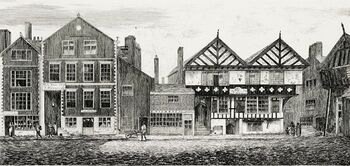
Number 12
A modern brick building, with no interesting features (this is not a listed building). However, unlike some of the other modern buildings it does not look out of place. This building is on the site of the "White Bear". Batenhams illustration of c1816 shows that the building at that time had the row-high porch and steps to the row level which typically indicate an enclosed row.
Number 14
Number 14 is a four storey, one-bay town house. The present structure dates from the 18thC, but has medieval origins and is built on the same narrow plot. The undercroft, 4 steps down, has surfaces of front bay covered and modern metal spiral stair inserted. Further back, the medieval sidewalls of coursed red sandstone rubble are exposed as are 3 oak cross-beams, 2 chamfered. The second storey has some old cross-beams, probably re-positioned.

Numbers 16-24 (Bridge House)
Bridge House was built in 1676, altered 1678 for Lady Mary Calveley, occupied early 18thC by John Williams, Attorney General of Denbighshire and Montgomeryshire from 1702 and Cheshire and Flintshire in 1727. Lady Mary Calveley, was the still young (and very wealthy) widow of Sir Hugh Calveley of Lea (who died 1648). Mary Calveley had petitioned the City Assembly for permission to demolish her existing house, which contained a section of the Chester Rows, and replace it with a well-proportioned Baroque Neo-classical mansion. The petition read that she wished:
- " ..to take down the fore part of her house in the Bridge Street by her lately purchased .. and to rebuild the same Roe as may bee a grace and ornament to the citty"
This was granted, but as it led to the loss of a portion of the Rows she was fined £20 (£2,900 as of 2014). Two years later a second petition was submitted for a pair of stairs out in the street, for which an additional fine of 40 shillings was required together with an annual rent of 5 shillings:
- "Thomas Wright, ironmonger, petitioned for liberty to put forth his shop in the Bridgstreete a foot street-ward so far as the street door of Lady Mary Calveley. He was granted this liberty for 20s. fine and 5s. yearly rent. Lady Mary Calveley had lately built a large pair of stairs upon the public street before her house in Bridge streete. It was ordered that she might have a fee-farm of the ground on which she had built for 40s. fine and 5s. yearly rent, provided she accepted before Christmas." (ZA/B/2/188-188v 20th Sept., 1678).
Mary Calvely apparently lies buried at Bunbury, in an elaborate tomb belonging to an earlier Hugh Calveley. How that came about remains something of a mystery.
The rear best displays the character of a substantial late 17thC town house. Seen from the front, the house is set back from the street frontage, but an Edwardian extension now breaks forward at ground level in the place of a pair of curved steps. A central window now replaces the original doorway.
The O.S. 1:500 plan surveyed in 1872 shows the present sixth bay, but also the external stairs and no projecting shops. At that time, the demand for secondary education in Chester was still largely being satisfied by private schools: in 1871 there were at least 40 private schools in Chester, 30 of them for girls. Several of the larger and longer established boys' schools in the 1870s occupied such notable buildings as the old Albion Hotel and Bridge House ("Bridge House School", run by a Mrs Keats and known for its gardens at the rear) in Lower Bridge Street, 'Derby House' (Stanley Palace) in Watergate Street, and Forest House in Foregate Street, though Gamul House had closed as a boarding school in the 1860s. Following occupation as a school, the building became the "Oddfellows Lodge and Club" (see Charters for more).
Later still, the building's ground floor housed the booking office for the "Crossville" transport company which was formed as Crosville Motor Company Limited on 27 October 1906 in Chester, by George Crosland Taylor and his French business associate Georges de Ville, with the intention of building motor cars. The company name was an amalgam of 'Crosland' and 'de Ville'. In 1909 Crosville had commenced its first bus service, between Chester and Ellesmere Port. By 1929 Crosville had consolidated an operating area covering the Wirral and parts of Lancashire, Cheshire and Flintshire.
- Oddfellow's Hall on Wikipedia;
- The other Hugh Calveley on Wikipedia;
- More on Crossville;
- Oddfellows Hall is now a quirky club, and retained the name;
Numbers 24-42
Numbers 26-42 are a group of houses dating from 1982-83 with some of the facades being facsimiles of the 18thC houses which stood on the site. As can be seen from the photograph taken just prior to redevelopment this part of Lower Bridge Street was very run down by the early 1980's, with many buildings on both sides of the street derelict.
Number 44
Number 44 has a 17thC or earlier core and front probably 1717, when the Row was enclosed following a petition by Thomas Hunt. Old stone end-piers, the north one rendered, rise through first and second storeys, which were formerly the undercroft and Row. Ceiling beams in the former Row level contain mortices for partitions, representing the line of the Row and the shop unit behind.
Number 46
Number 46 has thirteen repaired steps leading to the former Row level in a tall round-arched recessed porch. There is no evidence of earlier fabric.
Number48-50 (The Old Kings Head)
The Old Kings Head or ("Ye Olde Kynges Head") is first mentioned in 1208 in written records which refer to a stone-built house belonging to Peter the Clerk (an administrator at Chester Castle). The cellars behind the range facing Lower Bridge Street contain medieval stone walls, probably a survival from Peter the Clerk's "domus lapidus", but are much altered later. They form an irregular group of small rooms, but appear always to have been sub-divided, unlike other Chester undercrofts, which tended to one large space. The house was rebuilt from the former Row level upward and refronted probably in part 15thC, 16thC and early 17thC for Randle Holme I, first of four generations of heralds and armorial painters. The building was first licensed as a pub in 1717.
The structure of the Old Kings Head is unique in Chester, and the original hall was quite unlike that of later buildings as it lay behind rather than above the row and therefore had no windows to the main street. The the Castle Street elevation of the rear wing is the oldest surviving part of the building and can be dated to the late medieval prior to the period of intense rebuilding of 1550-1640. The sill-bean is of two pieces joined by a simple through-splayed scarf joint, and some studs have been removed for the insertion of later windows. One remarkable example of the re-use of former woodwork in moderisation is found in the arcade post which has been laboriously re-carved into a Tuscan column.
The premises were heavily renovated in 1935 and during this refurbishment a sword was found hidden under the floorboards of bedroom number 4. The said sword can now be found hanging proudly on the wall of the bar.
Even if intending to continue down Bridge Street it is worth a short diversion into Castle Street to examine the side of the building. This bears the sculpted head of a winking devil (one of those on the "Chester Imp Trail" and an odd sign advising against "nuisance".
Ghosts
- A phantom child is said to roam the pub, especially bedroom No. 4. A phantom figure has been seen wandering aimlessly about. The pub was renovated in the 1930's, and under the floorboards of bedroom number 4, a sword was found. It can be seen hanging on the wall today - is there a connection between the ghost and the sword? Mysterious messages have been said to appear on a mirror in bedroom No. 4.
- On New Years Eve 1982 a lady was delivering a car to a car dealer in Chester. She booked into room number 6 for the night There are 2 ways of reaching room number 6, and old and peculiar little stairway or a longer route by the modern and wider staircase. At 2am the lady awoke with an intense feeling that something was not quite right. She heard a clock strike 2, and felt a sensation of great cold, coupled with a feeling of her hair standing on end. She turned round and saw a man dressed in black silently watching her. She was quite indignant and puzzled, and wondered how a stranger had managed to enter a locked bedroom. She challenged the man, who simply carried on gazing at her. She wasn't alarmed, but rather felt a sensation of peace and tranquility. The apparition remained for about 15 minutes then vanished. The lady was so impressed with the soothing and comforting atmosphere that she booked to stay another night. Items have also been said to mysteriously disappear in bedroom No. 6.
A landlady has professed to be being very reluctant to use the small staircase adjacent to rooms 4,5 and 6, rather using the more modern staircase.
- Ye Olde Kings Head at their own website;
- Old Kings Head on Wikipedia;
Lower Bridge Street West (Castle Street to Shipgate Street)
Numbers 1 and 3 Castle Street
1 and 3 Castle Street are one or possibly two town houses dating from the mid 18thC. The east face to Lower Bridge Street has eight steps down, parallel with front, to former undercroft with lantern arch and replaced rail. The undercroft has a brick barrel vault of 18thC type. No evidence exists for a former Row.
Gamul House, Numbers 52-58
Gamul House has an undercroft (large longitudinal oak beam with reset joists, some replaced) at street level and service wing of two storeys. Three small one-storey shops, probably 18thC, but altered, are built against the southern bays of the undercroft and have brick barrel vaults of an 18thC type. Above and behind this is a stone built great hall of two-storey height at former Row level. An external stair parallel with the front has 15 stone steps leading to an access gallery in place of former Row to Gamul House and properties south of it. Parts of the present building date from around the early 16thC, with the oldest visible parts being the wall and fireplace behind the present bar. Following the Great Fire of London in 1666 and a Chester Assembly ruling on building in 1671, the medieval frontage of Gamul House was replaced by a brick façade.
Batenham describes the building as follows:
- "an old house which formerly belonged to the Gamul family celebrated as having given protection to that unfortunate monarch Charles 1 during the time the city was besieged by the parliamentary forces The interior is well worthy the inspection of the curious for its interesting old painted panel work and its beautiful carving A Baptist association now occupy part of the house as a place of worship."
Hughes writes:
- "up a flight of steps is a large tenement of late years known as the Boarding School Yard This was in the seventeenth century the mansion house of the Gamulls a worthy Cheshire family; and here on September 27 1645 Sir Francis Gamull Mayor of Chester in 1634 lodged and entertained Charles I on his Majesty's visit to Chester during the great Civil War The house is now divided into tenements but several of the rooms still retain evidence of their original splendour."
Hemingway writes:
- Just below Castle street on the west side is an ancient structure to which there is an ascent by a high flight of steps the court within being known by the name of the Boarding schoolyard. This house which fronts the street was formerly the residence of Sir Francis Gamul who was a prominent character during the siege and it was in this mansion that the unfortunate Charles I took up his residence during his short and disturbed stay in the city. The house and outbuildings behind are now divided into several dwellings of an inferior grade and this property with that of the Dee mills passed by purchase from the representatives of the Gamul family to the late EO Wrench Esq whose descendant now possesses it. Even in its ruins there are yet in the interior some remains of its former magnificence particularly in one of the principal rooms where the chimney piece is decorated in a superior manner with the Gamul arms painted in the centre probably the work of the first Randal Holme. It seldom happens that degradation follows magnificence without some intermediate gradations and this is true in reference to this once abode of royalty. Between the years 1760 and 1770 these premises were occupied by a Mr Tench who kept an academy for dancing and a most respectable boarding school from which circumstance the present name of the place is derived. Contemporary with Mr Tench as a dancing master in Chester was a Mr Pickmore who also obtained some celebrity as a teacher in this line. There is a curious coincidence worthy notice involved in the immediate descendants of these gentlemen. The son of Mr Tench entered the army as a lieutenant in the marines in which capacity he was employed by government on a voyage to the then infant colony of New South Wales of which after his return in 1793 he published an excellent history and passing through the different gradations was raised to the rank of general in the service which he still sustains. Mr Pickmore's son chose the navy for bis scene of enterprise and acquitted himself in such a satisfactory manner in his professional duties as to obtain a gradual advancement to the rank of admiral in which capacity he had lately a command on the Mediterranean station. Both these distinguished individuals are natives of Chester.
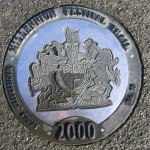
The marine Tench was the son of Fisher Tench the dancing master was Watkin Tench a marine officer who is best known for publishing two books describing his experiences in the First Fleet, which established the first settlement in Australia in 1788. His two accounts, "Narrative of the Expedition to Botany Bay" and "Complete Account of the Settlement at Port Jackson" provide an account of the arrival and first four years of the colony. The other is Francis Pickmore appointed governor of Newfoundland in 1816, where he stayed the winter, then died.
Thomas Gamul was the city’s recorder and was the son of Edward Gamul, who was the mayor of Chester on four occasions. At the time of the Civil War the house was the home of Sir Francis Gamul, the son of Thomas, a Royalist supporter and colonel of the Town Guard. Charles I stayed in the house on 23–24 September 1645, when his army was defeated at the Battle of Rowton Moor. Gamul and other Royalists were dismissed from the town's administration in October 1646, and he was fined £940. Gamul died at the age of 48. Gamul had married Christian Grosvenor daughter of Sir Richard Grosvenor (1st Baronet) in 1621. They had two daughters, and his baronetcy therefore became extinct on his death.
- Gamul House on Wikipedia;
60-68 and 2-6 Gamul Terrace
Numbers 60-68 are five lock-up shops and five cottages, built in 1872 by T Fluitt on the site of "Boarding School Yard". The shops project beneath the access gallery to the cottages, which is probably on the line of a former Row. A covered stepped access between shops numbered 60 and 62 leads up to Gamul Place, a courtyard development of eleven cottages built at the smae time. The whole was restored by Chester City Council in the mid 1970s. Gamul Place is the only surviving example of occupied courtyard housing in the city center.
Numbers 70-74
Numbers 70-74 are two late 18thC, four storey, brick town houses. The stair in a tall recessed porch to No.70a, north of No.70 and to No.72 south of No.74 suggest enclosure of the former Row.
Numbers 76
Number 76 is listed, but has no features of interest for the curious passer-by.
Number 78-82
Richard House has a facsimile facade of the previous building on the site, which conceals a modern steel framed building of 1983. The warehouse and town houses originally built here in the mid to later 18thC had a full height loading bay at the north end and an L-shaped stone stair of 5 and 4 steps to the south. The former loading bay is weather-boarded and has a casement to each storey, which were each formerly a loading-door.
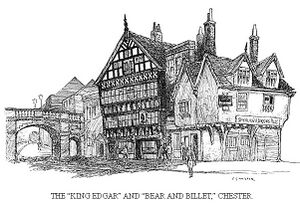
Lower Bridge Street West (Shipgate Street to Bridgegate)
Ship Lane (as it was known) connected the Shipgate with Lower Bridge Street and was certainly in existence by c. 1290. A modest thoroughfare, described merely as 'a way for a horse and a man', it was the site of the residence of the rich citizen Philip the clerk in the early 13th century and thereafter of property belonging to the Bruyn family and later to the Troutbecks, serjeants of the Bridgegate. An alternative name, Rabys Lane, derived from the family who held the serjeanty of Bridgegate in the 14th century.
Old Edgar
the "Old Edgar" has been described in "The Old Inns Of England" (1906) thus:
- Until quite recently the “King Edgar” inn was the most picturesquely tumble-down building in Chester, a perfect marvel of dilapidation that no artist could exaggerate, or any one, for that matter, care to house in. But it has now not only been made habitable, but so “restored” that only the outlines of the building, and that faded old sign, remain recognisably the “King Edgar.” It is now rather a smart little inn, displaying notices of “Accomodation for Cyclists”—spelled with one “m” — and thus, so renovated and youthful-looking, as incongruously indecent as one’s grandmother would be, were she to let her hair down and take to short frocks again.
This 14th or 15thC building occupies an important corner site, and may have originally been two buildings, before being converted into an inn. The jetty-bressumer to each front carries round-ended joists with sole-plate above, with brackets north and south and a repaired heavy gently-curving north-east corner bracket formerly rising from pavement to jetty.
- Ye Olde Edgar on Wikipedia;
Numbers 90-92
Number 92-93 has a brick facade of the early 19thC which conceals a timber framed building of somewhat unusual design and probably 15thC origin or earlier. Batenham shows a pair of front gables, but since the early 19thC these have been concealed by a tall parapet. Originally a timber-framed buiilding of two storey height, this was increased to three storeys and apparently largely cased in brick with four cross-casements to the front in the 17thC. Inside the original structure of the ground floor is largely obliterated by later alterations. However, the front room has a chamfered cross-beam, perhaps reused and altered, posts in side-walls and studded south wall. It aslso has the lower part of a massive 2-storey post c300mm x 300mm belling out to nearly 450mm x 450mm at its crown, suggesting a former 2-bay great hall. The second storey has a good full-width front room with small oak panelling to rear wall and matching doors, sub-panels to embrasures and 4-panel ceiling with ornamental early 17thC plasterwork on the 2 side-beams and the rear frieze and cornice.
Bear and Billet

The Bear and Billet was built in 1664 as the town house of the Earls of Shrewsbury who held the hereditary serjeancy of the nearby Bridgegate. It was possibly, given its proximity to the Dee Mills used as a grain warehouse (in the gable are double doors and a bracket for a hoist). The building became an inn in the 18th century, although it continued to be owned by the Shrewsbury family until 1867. Its name is taken from the heraldic device of the Earls that consist of a bear tied to a billet (or stake). In the Batenham illustration it is called the "Bridgegate Tavern".
The building is constructed in timber framing with plaster panels. It consists of cellars (but no undercroft), above which are three storeys and an attic in the gable overlooking the street. Each storey is jettied above the storey below. On the ground floor are two doors, one to the south and the other placed more centrally. To the right of each door is a three-light window. At the base of the first floor are 16 rectangular timber framed plaster panels. Above these is a window occupying the whole width of the facade and divided into 32 lights separated by mullions and transoms and containing leaded lights.
In the second floor storey are 12 arched timber framed panels. The window above these is similar to that in the first floor. Over this window is a row of 12 square decorated timber-framed panels. The jettied beam to the attic storey is inscribed "16:HH:64" and has a running vine pattern. It is rumoured (but by no means confirmed) that the front of the Bear and Billet contains well over 1664 individual panes of glass. In the attic is a double timber door surrounded by panels. On each side of this door, and above it, are two-light windows containing leaded lights. In the apex of the gable is herringbone timber framing. The bargeboard is carved and has a finial at its peak.
- Bear and Billet at Wikipedia;
Lower Bridge Street East (Pepper Street to St Olaves Lane)
Windsor House
An office block (with shops on the ground floor) of 1974-5 by John Taylor of Edmund Kirby and Partners. Built on the site of the former Red Lion Inn. The mansard roof of the office building is made of the innovative lead coated steel panels developed and manufactured at the Leadworks in Chester, which predated more modern aluminium/plastics composites and which, unlike some of the modern panels, are completely fireproof.
Number 9
Number 9 has frontage which is early 19thC but it masks a section of Windsor House behind the back of the Row walk, and so the interior was rebuilt 1970s and contains no original features. A tall round-arched recessed porch, has cast-iron gates to a dozen stone steps leading to Row walk of Nos.11 and 11A Lower Bridge Street.
Number 11 and 11a
Number 11 together with 11a contain the last section of The Rows left open in Lower Bridge Street. The undercroft at number 11 is pre 18thC, and was extended 18thC. The frontage dates from c1760. The building is unusual in that has a probably early 19thC rock-cut cellar 2.4m below floor level with damaged rock-cut steps. Also unusual is that the floor at ground level is slightly higher than the street rather than slightly lower (which is the norm in central Chester). The stall-board is rather deep and if this was the case down all of Lower Bridges Street it can be seen that there would be considerable incentive (in terms of room gained) in enclosing the Row.
Number 15
Number 15 is an undercroft probably partly 14thC (but altered 18 and 19thC) with a irregularly bonded brick frontage probably early to mid 18thC. It is built on a narrow medieval plot. The upper storeys have flush piers of painted stone. At street level there are portions of medieval stonework of the undercrofts, repaired and altered in brick C18 and C20. Three sections are visible in No.15: the front portion of four bays is of brick with timber beams; the north and south walls of the central section have portions of medieval stonework, repaired and altered in brick; the rear portion has stone north and south walls repaired in brick, with 2 medieval cupboard recesses in the south wall, and a sandstone east wall with evidence of a medieval rear access stair. Some good 18thC paneling survives in the room at Row+1 level. The Chester Toy Museum once occupied the enclosed Row Level but has now closed.
Number 15a
Number 15a has a tall recessed porch, with eleven steps to the former Row. The porch has a round-arched head. The building has medieval origins, but has been altered 18thC and later. The is a moulded cornice beneath the parapet with a round-headed central panel having a blank shield and, to each side, a balustrade with recessed end-panels. The front part of the shop occupies an undercroft probably of later medieval origin, with a 18thC brick barrel-vaulted section behind.
Numbers 17-19
The four storey two bay stucco frontage of the early 19thC numbers 17-19 conceals a vestigial Row, now a spinal corridor within the building. Until the mid 1990s this gave access to further properties to the south, and was separated from the street by a chamber constructed on the stall-board (this arrangement only survives at two other places on the Rows, both in Eastgate Street). The street level shop is divided two undercroft like spaces with ceilings carried on beams which are probably medieval.
Numbers 21-23
A Vernacular Revival revival building of 1895, probably by W M Boden for J R Crawford. No evidence of earlier fabric survives.
Number 25-27
The restaurant on the ground floor is about the only good thing about this Brutalist 1960s office building by the Biggins Sargent Partnership.
Tudor House
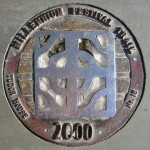
"The Tudor House" is briefly mentioned by Hughes:
- "We are now descending Lower Bridge Street which abounds on either side with those queer looking tenements not to be met with in such numbers and variety in any other city but Chester Here is one with the date 1603 evidently the residence in its earnest days of some Cestrian magnate long since returned to his dust."
Probably indeed dating from 1603 (which is the very last year of the "Tudor" period), extended to rear early-mid 17thC and altered in detail 18thC and later. The facade is a combination of Tudor and Georgian architecture with the lower half of the building being more Georgian in character and with the timber framed upper half being typically Tudor. The lower two storeys are brick to the front, but with an oak corner-post. The shopfront of painted brick has an oak door in Tudor-arched case with a 19thC two-pane shop window to each side with head-boards inscribed "TUDOR: HOUSE". Above the door is an erroneous date-plaque "1503". A jetty-beam at what would have been the top of the row level has strapwork-carved fascia on 4 brackets. The third storey has two 3-light mullioned and transomed leaded casements set proud of the wall-face. The fourth storey jetty is similar to that of the third storey. The alley on the south side has the name of, Hawarden Castle Entry and slopes up sharply. Inside, the cellar, in east part of south bay, is rock-cut with sump in middle, stone steps south west and earlier steps to a blocked entrance. The undercroft has a central wall, front to back, with openings. The Row + 1 level is notable for the plaster ceiling of the great chamber which is similar to that at Bishop Lloyd's House and may be from the same craftsmen. The Row was enclosed 1728 by Roger Ormes.
In the early 1990's the ground floor of Tudor House was a record shop selling 60's-to-punk music and PVC "cat-suits" displayed on the walls. According to tourist guides it is said to be haunted by a headless Cavalier who lost his head to cannon shot during the Civil War and "now gazes out of an upper window" (quite how we don't know).
Number 33
Number 33 is an undercroft and town house, of medieval origin but largely rebuilt and refronted 18 and 19thC. The rear portion, perhaps formerly longer, has an 18thC brick barrel vault.
Number 35
Number 35 was built in c1717, for John Warrington. Timbers in the deviding wall to number 37 exposed during refurbishment provide evidence of an enclosed row.
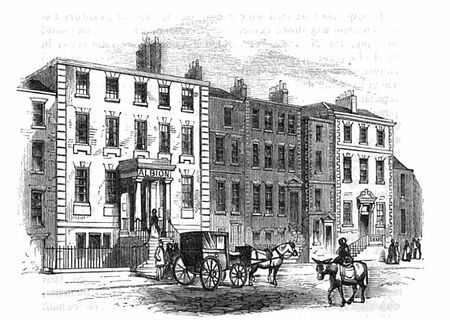
Park House
Park House was built in 1715, for Elizabeth Booth and later became the Albion Hotal, then the Talbot Hotel. It briefly housed the Assembly after the Exchange Fire and before the completion of the Town Hall. Later it became the Library before that moved to new premises. The undercroft is well below street level. The former Row level central entrance has projecting Tuscan porch with seven repaired steps to a sheltered landing between curved wing-walls of painted stone and a further four steps from landing to entrance. Batenham writes of it:
- 0n the left hand side of Lower Bridge street a new hotel has been established and elegantly furnished to which has been added a large assembly room and has the advantage of an extensive piece of ground behind laid out as a bowling green and a flower garden. In conjunction with this is a handsome spacious house opposite for billiards and news rooms.
Hemingway gives a little more information:
- Within these few years an excellent hotel has been established here called the Albion Hotel on premises formerly held by the late Bagot Read Esq elegantly fitted up to which more recently has been added a commodious assembly room and behind the premises is an extensive piece of ground laid out as a bowling green and a flower garden. Immediately opposite an excellent house lately occupied by the Misses Hunt and connected with the proprietary of the hotel has been converted into a subscription newsroom to which billiard rooms and other conveniences for public purposes are appended.

Hughes is his usual effusive self:
- But see yonder rattles a bus with a party from the station down to that first class establishment the Albion Hotel. This house has no superior in the city for while of handsome external proportions its interior arrangements have all been conceived with especial regard to the comfort and convenience of visitors. The Assembly Boom is the largest in the city the other rooms are light and lofty in short under the zealous superintendence of Mr and Mrs Chambers: none who once make acquaintance with the Albion will ever sigh for better or more comfortable quarters. Behind the Hotel are extensive pleasure grounds as well as a verdant and spacious Bowling green to which there is a carriage entrance from Park Street.

The ballroom at the Albion was, at its time, the largest in Chester was is sometimes erroneously reported as being the site of a civil banquet held for the Duke of Wellington who stayed at the Albion when he visited Chester in December 1820. This must have been an interesting affair as political tensions in Chester were high at the time:
- "..a grand public dinner for the duke of Wellington, presided over by Barnston at the Exchange, 28 Dec., after Lord Grosvenor forbade the use of the town hall for the occasion, commanded attention in the last months of 1820.." [1]
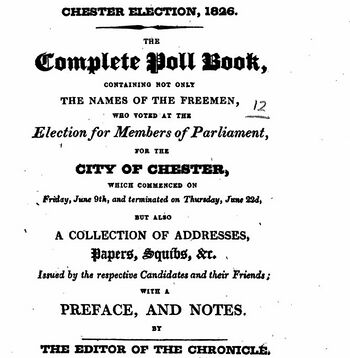
Hemingway (in 1831) writes (rather defensively - I'm sure there is a story in there somewhere):
- "On the 23rd of December the Duke of Wellington by invitation paid a visit to Combermere Abbey the seat of his friend arid companion in arms Lord Combermere. A knowledge of this fact having transpired a numerous meeting of the gentry and principal tradesmen of the city was held at the Exchange when it was unanimously resolved to invite the hero of Waterloo to a grand public dinner. A deputation being appointed to wait upon his grace to obtain his consent the following Wednesday the 27th was fixed upon when his grace accompanied by Lord Combermere and suite arrived within our walls. He took up his quarters at the Albion Hotel from whence he made a short excursion to the castle inspected that building armoury etc and afterwards proceeded to the Exchange where a most sumptuous banquet had been prepared. Colonel Barnston presided at the festive board which was surrounded by about 150 guests amongst whom were Lords Combermere Hill and Kenyon, Sir WW Wynn, Sir James Lyon, Sir HM Mainwaring, Col Thomas Cholmondeley, Major General Beckwith and other individuals of distinction. During the evening and indeed white he remained in Chester his grace received every mark of respect that could be shewn to a character whose eminent services in the field of honour had entitled him to the gratitude of his country .It has been spoken of as a subject of regret that the usual compliment of presenting the duke with the freedom of the city was omitted but I am inclined to think that this omission arose solely from a mistake or misapprehension in some of those individuals whose business it was to attend to the necessary proceedings and not to any intentional disrespect."
Roger Barnston of Forest House, in Foregate Street was the local militia colonel. It is notable that the then MP for Cheshire, Grosvenor, was considered an "enemy" by Wellington and eventually, a few years later after Wellingdon became Prime-Minister, helped to vote him out of office. However in 1828 Hemingway had moved his newspaper editorship from the Courant to the pro-Grosvenor Chronicle, and so may be being a little disingenuous.
The Chester Society of Natural Science was formed in 1871 at the instigation of Charles Kingsley, then canon of Chester Cathedral at his Residence, Abbey Square, first meetings being held at the Old Palace. Early lecture courses were held at the King's School while regular annual conventions were held at the Town Hall. A museum was briefly established in the Albion rooms, later transferring to the newly built Grosvenor Museum. By 1910, Park House was the location of the "Chester Working Boys Home", and later became the offices of the Libraries Department of the then County Council.
Number 43-47
Actually dates from 1990-91 and is a brick-faced office building in a Neo-Georgian style by Peter Catherall. However it is almost a perfect copy of the previous building on this site (Liverpool House) which had become largely derelict by 1960 (see photo left). Prior to redevelopment the last use of Liverpool House was as a lodging house - it bore a sign advertising "Clean Beds amd Good Kitchen".
Number 49
Number 49 is a single bay, four storey brick building of the mid 18thC with basement. Externally there are nine steps down to the basement, and four steps up to the apron landing before a pedimented doorcase with fluted pilasters.
Number 51
Number 51 was built in 1700 for John Mather, a lawyer. In 1699 John Mather, petitioned to build a major new house on the east side. He had recently purchased an old house and a small 'showing', or street level stall, and desired to build a new house which he hoped "...will be some ornament to that part of the street". Permission was granted in 1700 to build a new house, 51 Lower Bridge Street, and this reinforced the increasing trend for the newer properties in Lower Bridge Street to be purely domestic rather than the mixed commercial-cum-domestic properties of earlier centuries. The house departed from the plan form imposed by the Row walkway and was the second new house to be built in Lower Bridge Street after Lady Mary Calveley's Bridge House. The brick facade has a rendered plinth to the former row level. A staircase parallel to the street leads to the main entrance and its quarter landing provides a porch to the basement doorway. The substantial painted stone door case has an eared bolection architrave on square plinths and a broken scroll pediment on consoles.
Number 53
Number 53 is a humble little dwelling next to the Georgian neighbours, is of medieval origin (16thC) but altered early 18th and 19thC. Timber framed, it has a rather jolly late 19thC parapet on the front gable end, of patterned red and yellow brick with terracotta coping and a ball finial.
On the south side to St Olave Street the framing displays phases of building in a remarkably clear manner. Medieval red sandstone rubble walling remains towards the rear, and a few visible stones can be seen further west. The late medieval posts, west of the bay containing the westernmost window to the first and second storey, marks the front of the former Row walk. Carpenters' marks are numbered from rear of the former Row walk, westward in the Row and stall-board bay, eastward in the domestic bays behind. The secondary framing in the Row and stall-board bay is probably late 17thC. The flue from the fire is taken up through what would otherwise appear to be a south chimney of the adjacent number 51, probably when that much taller building was constructed and the Row closed in 1700.
Lower Bridge Street East (St Olave Street to Duke Street)
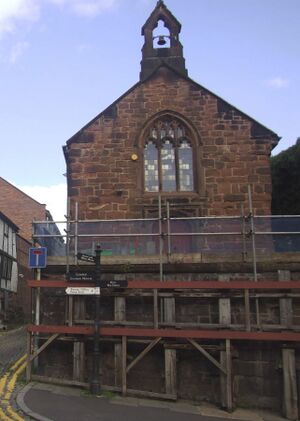
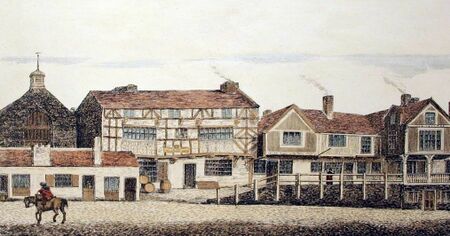
St Olave's Church
St Olave is described by Batenham as follows:
- "Passing on we come to St Olave's Church a small mean edifice said to have belonged to a monastery but of what order cannot now be ascertained. In speaking of this place as of many others to be mentioned we have sincerely to lament our inability to give the dates and particulars as they have not been preserved to us. It is probable that during the frequent troubles and vicissitudes the city has been exposed to the public records have been destroyed or so carefully concealed as to defy research. However as more laborious writers have failed in this particular we satisfy ourselves that the deficiency is here excusable. Respecting the above church it may have been reserved for the use of the parishioners after the suppression of its parent establishment at the general dissolution of religious houses".
Where Batenham describes the Church as "mean" Hughes writes:
- "Only a step or two from the Albion and on the same side near the residence of Mr Snape the eminent dentist is St Olave's Lane so named from the Lilliputian church dedicated to that saint at its south west corner. This Church dates back earlier than the Conquest. The advowson in the eleventh century was vested in the Botelers or Butlers from whom it passed by gift of Richard Pincerna in 1101 to the Abbey of St Werburgh. St Olave's appears to have been always in low water a starving rather than a living for in 1393 on account of its poverty the parish was temporarily united with St Mary's. Down to the seventeenth century however it eked out a precarious existence but after the close of the civil war the ordinary services of the church were discontinued for about a century when they were again resumed until the final extinction of St Olave's as a distinct parish in 1841. In that year the Church was finally closed and the parish united to that of St Michael. The "powers that be" are fast allowing this ancient structure to develop into a ruin."
Founded in the 11th Century, the present building probably of mid 15thC, restored with some alteration 1859 by James Harrison and converted to exhibition centre with little alteration in the 1980s. The forecourt walls, which formerly supported a building in front of the Row walk, are of medieval origin. The side walls lean outward noticeably. The forecourt at former Row level has sandstone rubble retaining wall with a flight of ten simple stone steps up from St Olave's Street.
Rotten Row
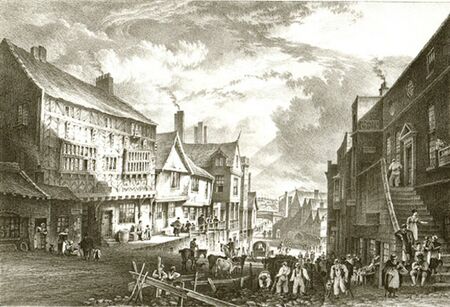
Seacome writes of what comes next:
- The Rows in Upper Bridge street are still entire and continuous but in Lower Bridge street they have been discontinued in the more modern and built up and appropriated in many of the ancient buildings so that there only remains a small portion of the Row on the east side towards the foot of this street and that in a state of dilapidation which renders its shelter more perilous than pleasant to the passenger.

Hughes is remarkably silent when one would expect something like:
- "Whay-hey! Now what is this! a drunken brewery"
However the modern location is a sad disappointment. The site is occupied (in 2014) by a large concrete and brick motor garage, erected in the 1960s and totally out of keeping with the surrounding buildings. Here, in a dreadful clash with Gamul House, the architect has either: tried as hard as possible to make a statement about the ugliness of modern design in the wrong context, or simply gets it so wrong.
Batenham writes:
- "Immediately adjoining is a very singular ancient building now occupied as a brewery the date of which is likewise uncertain. From the prodigious thickness of its walls and its huge beams and supporters it appears that the builder whoever he was intended it as a perpetual monument to his fame nor is there any reason to doubt its security. In the interior are several entrances to vaulted passages now blocked up but what communication they ever had is not known. In addition to this it may be stated there is a very popular opinion which we can neither confirm nor disprove that subterranean communications have been made between the Castle and various public buildings in the city though what their purpose was or why discontinued is wholly unknown. The many remains of arches still to be seen both here and in the cellars of certain houses in the principal streets are however strongly corroborative of the belief."
The building in question was initially the home of "Richard the Engineer" ("Richard L'Ingenour") the royal master mason of Edward I. L'Ingenour held the manor of Belgrave and was responsible for the purchase of materials and making of contracts with craftsmen. In 1275 he was granted the lease on the Dee Mills, and later renewed this lease (in 1284 for 12 years at the immense cost of £200 year - however it was compulsory for most citizens to have their corn ground there). Under the supervision of L'Ingenour, Richard de Paris made considerable alterations to Chester Castle. The building was known as "Pareas Hall" after its sale by Richard the Engineer's son Almaricus, in 1321, to Robert Pares (or Praers). There appears to be some confusion as to whether Robert Pares and Richard de Paris are the same person or two different people.
What we know of Richard the Engineer is that he first appears as the superintendent of works on the outer bailey of Chester Castle in 1265. He is therefore unlikely to have been born after 1240. His first mention in the royal records is in 1277 when he was put in charge of 1850 men (including 970 diggers, 330 carpenters, 320 woodmen, 200 masons, 12 smiths and 10 charcoal burners) at Flint to begin work on Flint castle. Richard then vanishes from the royal records for a while. One possible reason for this could have been the great fire of Chester of 15th May 1278. It has been suggested that this fire led to the opportunity to rebuild Chester with The Rows. Richard reappears on 16th March 1281, when he joins Master James of St George at Flint and is now paid 10d a day, but may have been called back to Chester quickly as the Old Dee Bridge was swept away that year. In 1282 he is back in Wales again supporting a military expedition by first repairing Hope (Caergwrle) Castle, and then building a bridge of boats to cross the Menai Strait. In 1283 he is associated with early work on Caernarfon's castle and walls. 1284 has him procuring tools for Conwy. In 1287 he is at Carmarthen building a siege engine. This was used successfully but as Rhys ap Maredudd moved to another castle (Newcastle Emlyn) Richard's engine was hauled there by 60 oxen and used successfully again. Another revolt in 1287 under the leadership of Madog ap Llywelyn brought Richard back to military matters, preparing another bridge of boats for crossing the Menai Strait at Beaumaris. In 1303 Richard undertook a series of repairs at Chester Castle following a fire and the same year in January he was consulted over the possibility of building pontoon bridges during Edward I's war with Scotland. These were constructed in Norfolk, and sailed up to Stirling on 24th May. The abbot of Chester pledged substantial sums to Richard in 1310 and 1312–13 for work at the cathedral. Richard was elected Mayor of Chester in 1305. He also (before 1309) built a house at Belgrave, after beginning to acquire land in Eccleston in 1284. Little of the house remains other than the moat.
In the later C17, Randle Holme, the Chester Herald, noted that the building in Lower Bridge Street was a rare fortified town house:
- "This in ancient tyme was a famous structure of stone much like a castle or fort having an high tower".
Large stone town house with high towers are very rare in English medieval cities, so the builder must have held considerable influence as Richard the Engineer did. But what of the stories of the tunnels connecting various places around Chester with the Castle? Hemingway writes:
- "Opposite to Boarding-school-yard there is an antique structure now used by Messrs Newell and Gaman as an extensive brewery; the date of its erection is unknown, as well as the purpose to which it was formerly appropriated, but it may certainly be placed as early as the fifteenth century, and the row adjoining bears evident marks of remote architecture. In the interior are several entrances to vaulted passages, now blocked up, but what communication they ever had is uncertain. A very popular opinion has long prevailed that there anciently existed subterranean passages between the castle and various public buildings in the city, though for what purpose or why or when discontinued is wholly unknown. This idea received the authority of the author of the Polychronicon who says: "In this cyte been ways under erthe with vowtes and stone werke wonderly wrought; three chambred werkes". In remarking upon this passage Mr Pennant observes that of these not a trace nor even the least memory is left notwithstanding the most diligent search and inquiries have been made. None says he have ever been discovered by the frequent sinking of cellars for new buildings on the site of the old tradition has delivered no such accounts to us nor is their exit to be traced beneath the walls in any part of their circumference. It should be recollected however that Mr Pennant wrote upwards of fifty years ago and that since his time a greater number of reliques of antiquity has been discovered than before his time. I am not prepared to speak decidedly on the question but confess I am less sceptical on the affirmative part of it than formerly. There is some difficulty in accounting for the blocking up of passages and arches several yards below the surface of the ground without admitting the existence of continuous ways for some purpose or other and if we cannot ascertain their direct object yet the palpable fact is not to be denied or evaded. But what has most tended to incline me to a persuasion of the existence of these hollow ways were the appearances of a subterranean passage discovered on sinking the cellars for the buildings now standing on the site of the old Lamb row. Here was found a distinctly marked road about five feet wide and more than five yards deep from the level running the whole length of the building in an oblique direction and without termination at either end. The road seemed to proceed in a direct line from the site of the old Friary situate between Commonhall street and White Friars taking a slanting direction across the latter and pointing obliquely across Bridge street. At the time of sending this sheet to press the author is engaged in prosecuting a closer research into this subject the result of which will be given when he comes to notice our antiquities."
So whether Richard the Engineer had his own private escape route to Chester Castle or not, remains a mystery.
- Pareas Hall on the Gatehouse.
Bridge Place (Duke Street to Bridgegate)

Duke street was once Claverton Lane or Clayton Lane, but the name was changed around 1795 to Duke Street after the alderman and mayor (mayor 1740-41, died 1764) of Chester Thomas Duke (a wet-glover by trade). It is home to the Cheshire Record Office. Bridge Place is mentioned briefly by Hemingway:
- A little before arriving at the Bridge gate the street widens and a range of good buildings on the east side forms what is called Bridge place.
..and there is little of historical interest in these buildings:
Cross Keys
The Cross Keys public house, known to have been kept by a John Beavan in the 1740's was rebuilt in 1894 by WM Boden. It's raised forecourt is probably earlier. Internally the bar was completely refurbished in 2012 to create a Victorian look with oak floors, leather seating, etched mirrors and wood paneling. Each of the stained glass windows depict a "taphouse" belonging to the same brewery.
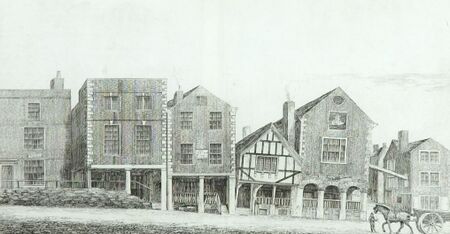
Bridge Place
1 Bridge Place c1770.
3 Bridge Place late 18thC.
5 Bridge Place mid 18thC.
7-11 Bridge Place late 18thC.
13 Bridge Place rebuilt 1970.
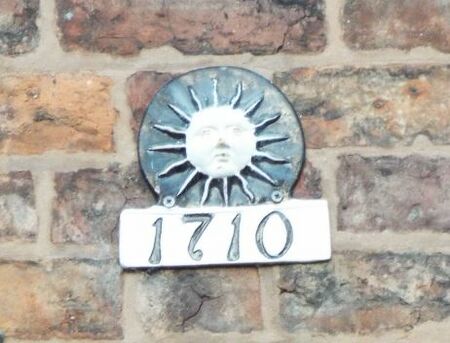
connect
Sources and Links
- List of businesses (out of date);
- Bridge Street, Chester from http://www.christleton.org.uk
